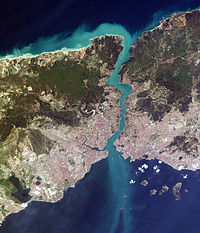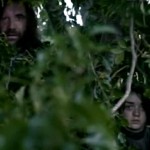 Link to the Ouroboros symbol. [ A good attempt of explaining the same will be found...’ The Serpent Grail’. By P. Gardiner and/or ’Serpent in the sky’. Mentioned elsewhere. Or even the 'fairy story' equivalent, 'The Green Snake and the Beautiful Lily' by J. Von Goethe. Think about it, relative to 'green' and 'lily' symbolism. [Egyptian 'Lotus', according to some, equates to the same].
Link to the Ouroboros symbol. [ A good attempt of explaining the same will be found...’ The Serpent Grail’. By P. Gardiner and/or ’Serpent in the sky’. Mentioned elsewhere. Or even the 'fairy story' equivalent, 'The Green Snake and the Beautiful Lily' by J. Von Goethe. Think about it, relative to 'green' and 'lily' symbolism. [Egyptian 'Lotus', according to some, equates to the same].
Side note: "It is a story about the profile and frontal view. The 'green snake' is the profile view, and the 'flower' of the story may be seen from the front..." ['The Zelator'. Emphasis, this readers].
I.e.,''In tomb inscriptions, the depiction of the deceased holding a lotus represents his reawakening in the spiritual plane....It is an object that lives in all the elements: Water, Earth, Air, and also aspiring to the 'fiery' world of spirit." [Chapter two, 'The Sacred Tradition of Ancient Egypt']. 'Ancient Alien' program [History channel. November 2014] identifies that same picture as an ''electric lance or rod'' - in the literal sense of the 'word'].
And/or..."...but if you are armed with the 'wand' of intuition, the 'cup' of sympathy, the 'sword' of reason and the 'pentacle' of valor, you will find there {the legends say} the Medicine of Metals, the Elixir of Life, the Philosophers Stone, True Wisdom and perfect happiness." [Extract from the book 'The Cosmic Trigger' by R. Wilson. Emphasis, this readers].
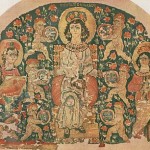
Hearth energies?
A more practical definition?: "The alchemical process is said to be one of sublimation. To sublime anything is to elevate it, to lift it up. The Hindus teach that power is coiled in the sacral plexus, and they call this 'power' Kundalini, the coiled serpent. Yoga practice is intended to lift this power from the 'lower' centers to the 'higher' ones, until at last it energizes the pineal body. In like manner alchemists talk about the 'raising of the metals' from Lead to Iron, from Iron to Tin, from Tin to Copper, from Copper to Silver, from dead Silver to living Silver {'quick' in ''quick Silver'' means living}. And then the sublimated Mercury is turned into Gold. What does this mean? Just exactly what the Hindus mean by the raising of the Kundalini. A release of the energies 'stored' in lower centers, and a change in their rate of vibration to that of the higher centers, accompanied by corresponding changes in consciousness...."
Refresher: ''A seed sized portion of the inner stone of personal effort will transform an enormous amount of leaden inertia''.
Understanding 'its' true symbolic intent throughout all ages regardless of time or place; by way of nothing more than objective analysis - instead of ones ''first impressions'' - gives a more plausible understanding to such phrases as..."There is a Qabalistic aphorism which states that, 'Kether [spirit or 'whiteness'] is in Malkuth [matter or 'blackness'], and Malkuth is in Kether, but in a different manner." [Chapter seven, 'The Philosophers Stone' by I. Regardie].
''White Stone''? Try Alice Roberts.
A little bit more added: but note; from a different source..."And here is the Hermetic mystery enshrined more than ever - that 'as above, so below'. In Kabbalah it is said that 'Kether is in Malkuth, and Malkuth is in Kether', and in Alchemy, ''the heaven is in the earth, but after an earthly manner; and that the earth is in the heaven, but after a heavenly manner." [Extract from the book 'The Magister'].
'Crown of Thorns'? {i.e., Crown {above} Thorns {below}.
That ''objectivity'' {or 'objectiveness'?} that can be applied to anything, its main components being those ''three'' universal constants. See Part 1.
'On Having No Head: Zen and the Rediscovery of the Obvious' / D. E. Harding.
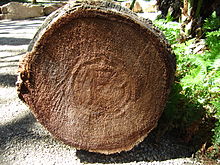
Sawn palm stem: Palms do not form annual tree rings.
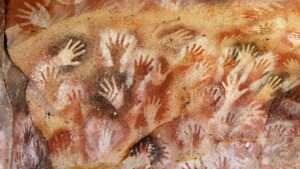 Define {'see'} the above to get an idea {''hang on''?} - the following: The Cerrigydrudion Crown. A Celtic piece of ancient artwork. Bronze {'red'?} and leather {'cow'?] headpiece. ''Possibly signifies 'warrior' headgear - with palm leaf and lotus designs - neither of which are common to these islands {UK}.'' ['Inside Museums: St. Fagan/Cardiff. Sat.TV].
Define {'see'} the above to get an idea {''hang on''?} - the following: The Cerrigydrudion Crown. A Celtic piece of ancient artwork. Bronze {'red'?} and leather {'cow'?] headpiece. ''Possibly signifies 'warrior' headgear - with palm leaf and lotus designs - neither of which are common to these islands {UK}.'' ['Inside Museums: St. Fagan/Cardiff. Sat.TV].
A working example: Recall Odysseus journey back to his homeland. Lotus island being its 'first stage'.
'Spirit/Soul' - as a means....?
Question. What would ''hang on'' be represented with - if anything?
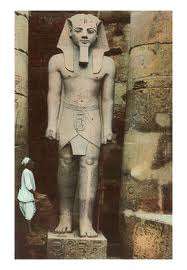
Best foot forward.
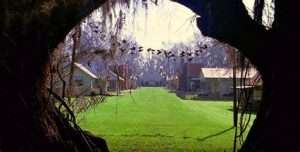
High wire act?
Hebrew equivalent..."The Self is one of the basic experiences of the human psyche, in that it is that to which we constantly refer our experience, both in the environment {external} and in our inner world. It is impossible to define these two worlds as separate except in our mundane experience, in that the so-called external world is in part - if not in totality - an experience equally generated by our own internal world. In Kabbalah, this is indicated by the separation of Tiphareth, 'Self-consciousness', to Malkuth by Yesod, the 'persona'. Our thoughts {Hod} and emotions {Netzach} constantly alter the process of Yesod {ego} in acting as our 'interpreter' of the environment {''guardian of the gate'' link. This readers input}, such that what we perceive is in fact our shared vision of the world, not the actual world itself." [Same book].
And/or..."The Alchemists also portrayed the First Matter as the ''Root of Itself,'' and its primary symbol became the Ouroboros. Drawings of the Ouroboros carried captions reading ''All is one,'' or ''One Thing is All.'' The circular snake [i.e., coiled] was sometimes shown with a half light and half dark body., alluding to those opposing principles....of which the yin-yang symbol of the Chinese Tao, was yet another symbol of the One Thing." [Chapter 4, 'The Emerald Tablet' by D. Hauck]. Again see Part 1 for a refresher.


Limpdick mont. Protocol ONLY? What about Health, Education, Security etc., etc., etc., etc., etc.,etc., etc, etc., etc., etc, etc., etc., etc.
Define the parts to understand the whole, i.e.,"Truth springs forth from the clash of opinions" - but actually it is not the truth which springs forth, but rather 'combative intellectual energy', for truth is revealed through the fusion of opinions and not through a clash {'clashing rocks'?}. A clash certainly produces intellectual energy, but hardly ever discloses the truth. Quarreling will never lead to truth, as long as one does not give it up and seek for peace. Certainly minds can be electrified by polemic, which can cause a veritable intellectual storm in the world; but polemic cannot make the clouds disappear, nor is it given to making the sun shine...Now it is through the fusion of opinions that truth lights up. Conversation the process of ''together versing'' [flowing together] - is the very opposite of controversy, the process of "contra-versing" [flowing against]. Conversation is the operation of the fusion of opinions; it is a work of synthesis. True conversation always has in principle the underlying statement from the Gospel - "Where two or three are gathered in my name, there am i in the midst of them". For all true conversation calls upon the transcendent center, which is the way the truth and the life...The Zohar is a historical document which, amongst other things,, supplies perhaps the best example of the creative role that conversation can play. There the Rabbis - Eleazar, Simeon, Jose, Abba and others - join their efforts and experiences with the aim of arriving together at a deeper, loftier and greater comprehension of the Torah...by way of the fusion and synthesis of opinions. Now, the force which is at work here is that of the 'virgin' [which the doctors of the Zohar call Shekinah], whilst the energy which electrifies polemicists is that of the 'serpent'. The force of life, and electrical energy: are these not the most clear manifestations of these two principles? Life and electricity, must be clearly distinguished. Thus, today there is a tendency to confuse them, and to reduce them to 'electricity' alone.  However, electricity is due to the antagonism of opposites, whilst life is the fusion of polarities..." [Extract; including parenthesis; taken from within the book by Tomberg]. Anything? ALL as a representation of something. At the very least can you 'see' something other than the "literal"? OR at least attempt to? Before those two bigger questions are asked.
However, electricity is due to the antagonism of opposites, whilst life is the fusion of polarities..." [Extract; including parenthesis; taken from within the book by Tomberg]. Anything? ALL as a representation of something. At the very least can you 'see' something other than the "literal"? OR at least attempt to? Before those two bigger questions are asked.
Question. Concave or Convex or the 'boundary' between the two?
"God unites the polarities of qualities ['aspects'] only in Adam, to confer a distinction on him. Thus he says to Lucifer, 'What prevents you from prostrating to one whom i have created with my two hands?' [Quran 38:75] .
Question. ''prostrate'' = 'horizontal' link {only}?
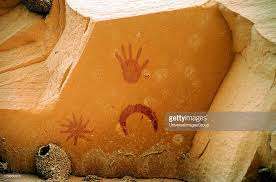
Overhang = overarching? Question. What would the remedy be? Stout Oak?
Analogy of same?..."The moon of delight [''joy'' link] who knows no wane'' is god; eternal Polaris, anachronous never. The ''moon of heaven rising once again'' is the outward cosmos, fettered to the law of periodic recurrence. Through Self-realisation this Persian seer had forever freed himself from compulsory returns to earth: the garden of nature or Maya. Christ expressed his freedom in another way: ''And a certain scribe came, and said unto him, Master, i will follow thee whithersoever thou goest. And Jesus said unto him, The foxes have holes, the birds of the air have nests: but the Son of man hath no where to lay his head." Spacious with omnipresence, could Christ indeed be followed except in the overarching spirit?" [Extract from the book 'Autobiography of a Yogi'. Emphasis [all] - this readers].
'Stretched'.
Nefertiti.
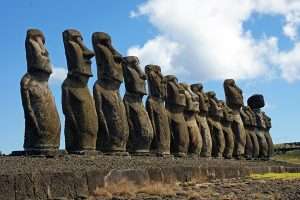
Created from volcanic rock on their backs in the horizontal position. Recall the later 'ritual' of bird, egg and island ceremony.
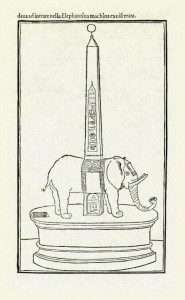
'Prince' link?
Working example: In the Colossal Temple of Seti 1st - scenes of boats {solar ones?} being taken on "carrying poles" from the ledge below which has an obvious overhang to it. It leads to an ascending corridor {''tunnel''} at the back of the temple then on to the processional way that leads to large ancestral tombs {Ten} made of mud brick {'wattle and daub'} belonging to the 1st Dynasty king {ivory plaque} - the largest of which is found a mummified right arm {with hand} with 4 bracelets. A river once flowed there between two mountain peaks - the mouth of which when dried up became the burial place.
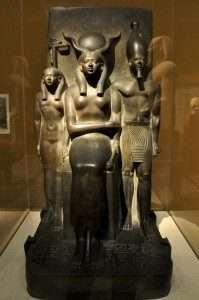
"Victory from the jaws of defeat."
The usual 'smiting of the enemies' scene depicted on the ivory plaque. A thousand years later a stairway of {ten steps?} added and a black basalt stone sarcophagus representing Osiris {in the horizontal position} with a bird of prey on top "watching the figure". Osiris link to the Osireion: "in a PIT fifteen metres deep" - an 'island' below the water table. Representing the primordial mound {wet/dry link}. In the descending tunnel/corridor leading to it can be seen: "Ra in his solar boat + monkeys, intertwined snakes and a sow in a boat." The question is asked why did Osiris become the dominant cult? ['Blowing Up History' / S9 EP7].
Osiris = generation {reincarnation} = 120.
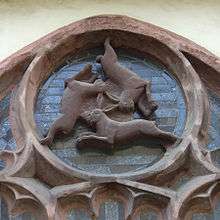
Man in the moon?
Resurrection = female aspect = GAP. As seen {as one example} in the Kings List at Abydos.
Raised and sunken relief.
Side note: Seti and Ramses temples = 6 apertures either side of main entrance. 'Thirteen' in total.
{Additional?} material to define the parts within the whole {now or later} : "...Thus there are serious reasons to believe {as G. A. Wainwright suggests} that the emblem of Min, which is of prehistoric origin, actually represents the thunderbolt. Whatever its variations, this symbol always expresses two opposing currents. Later on, the thunderbolt, symbolized by arrows or other projectiles, became the attribute of the sky god Zeus - Jupiter - Amun." [Extract from the book 'Egyptian Mysteries'].
''Wound/pierce'' link?

''The Volvo logo is an ancient symbol for iron.'' ['The Chase'].
Side note: ''Darjeeling {N/E India}, famous for its dark tea, is derived from the Tibetan word meaning 'place of the thunderbolt'....'' ['Tipping Point' / 2022].
''Triple-tonguing on a trumpet.''
And/or: ''The circle with a cross in it is a feminine symbol. One with an arrow is male.'' ['The Chase'].
AND: ''Thousands of Buddhists manuscripts were housed in a nine storey building at Nalanda {N/E India}. One Chinese scholar adored it here: ''There are richly adorned towers and fairy tale turrets. Roofs covered with tiles that reflect the light in a thousand shades. There are observatories, and the upper rooms tower above the clouds. These things add to the beauty of the scene.'' ['Genius of the Ancient World: Buddhism' / Bettany Hughes].
'Bower'?

Above/below the clouds?
''According to the early 7th-century Tang dynasty Chinese pilgrim, Xuanzang, the local tradition explains that the name Nālandā (Hindi/Magahi: नालन्दा) came from a Naga – serpent deity in Indian religions – whose name was Nalanda. He offers an alternate meaning "charity without intermission", from "na-alam-da"; however, this split does not mean this.[23] Hiranand Sastri, an archaeologist who headed the excavation of the ruins, attributes the name to the abundance of nālas (lotus-stalks) in the area and believes that Nalanda would then represent the giver of lotus-stalks.'' [Wiki].
Continued: "The next day of our journey in the Yucatan was unique for me. I had never seen the temple sites we were going to. These temples represented the dark side of male and female energies. There we would be doing two incredible ceremonies or processes there to release forever from our beingness the male-female polarities - leaving us free, with all our divine strength...In the two days of our trip from Tulum to Palenque, we all had a cohesive series of experiences and ceremonies that felt specifically designed by the Maya to accelerate us out of polarity and into Oneness, almost whether we wanted to of not.'' ['Serpent of Light Beyond 2012'].
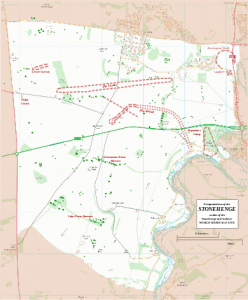
Cursus = ecliptic ? Mid - way - between wood/stone henges? Antler horns and shards of blue stones found within same {cursus}.. Define the parts to get closer to a MIND SET. Question. Male or female antlers?
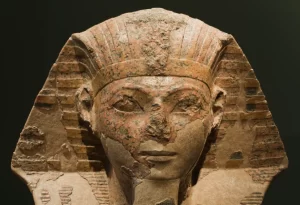
Hatshepsut {with beard}: ''Foremost of the Noble Women.'' And/or: To “beard” someone means to confront him boldly. So, it seems, does the divine Thor let us know who beards best. Imposing and content, he sits on his throne, his hands grasping—and displaying—both beard and emblematic hammer, the two rendered, in this bronze miniature, as one. The conflation between hammer and beard suggests that the beard has symbolic qualities equivalent to the thunderbolt’s hurled destruction and fecundating rain.
Additional material?..."The 'aegis' of Athene, both in the stories of Homer and in later legend, has given rise to the debate as to its purpose and its identity. It has been described as a round shield, but as Athene's legend developed it became a shield with a gorgons head and fringed with snakes, and later a goatskin mantle embroidered with a gorgons head and fringed with snakes. In astronomical terms, we believe the immortal aegis to be linked with the ecliptic and the orbit of Jupiter, which hugs the path of the sun. The planet itself might give the impression of a glittering shield. Athene, like Ares and Agamemnon, is armed with a huge spear - another concept associated with the ecliptic. Book 8 describes how she 'stepped into her flaming chariot, and grasped the spear so stout and sturdy and strong with which she quells the ranks of heroes who have displeased her'. Little imagination is needed to see majestic Jupiter 'grasping' the ecliptic on its journey across the heavens. Later in Book 8, Iris, the messenger of Zeus, says of Athene, 'but you, bold hussy, will you really dare to raise your huge spear in defiance of Zeus'? Iris rhetorical question may imply the futility of defying Zeus with an astronomical concept, the ecliptic, under his command. The path of Jupiter never strays far from the ecliptic..." ['Homer's Secret Iliad']. Continued elsewhere.
Side note: : "Jupiter is called in Egypt 'the star of the south' - for Jupiter-Amon-Min is the procreative energy; the liver is the energetic sun of the 'sexual' world and the 'ego'. In it presides the 'seed' of the Personal Consciousness, which, if awakened, can keep it in equilibrium..." ['The Opening of the Way'].
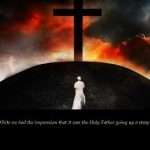
Any 'soldiers'?
And/or: ''Just as the name Amun-Re links Amun with the sun god, so too, as Amun-Min-Bull-of-his-Mother, he is united with one of the oldest Egyptian gods, Min, who was worsipped together with Isis, at the important cult center of Coptos in Upper Egypt. From this town the ancient Egyptians used to make their way into the desert region along the Wadi Hammamat, to the quarries which provided rich sources of gold, diorite, schist and other valuable stones; and Min himself was honoured as Lord of these hill countries.'' [Page 82 'Hathor Rising' / A. Roberts].
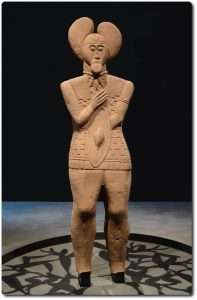
Difference of opinion or a different perspective? Lettuce ears or just vegetative ones? {i.e., mistletoe}.
Other keys that ''Min'' is identified with: 'Milk' sap of the 'lettuce' / 'Creates vegetation and lets the herds live' / 'Lord of snake of stones {'two'?} / 'Most 'male' of the gods' / 'Bull of the cows' / 'Bull of his Mother' / Annual Harvest Festival - link to 'emmer wheat' : 'seven' : ''soldiers'' : All in relation to: ''Ear of grain'': which contains the seed for the following year: to be revitalised in the comming year'. [Pages 79-86].
Refresher: ''A period of someones youth is described as their salad days.''
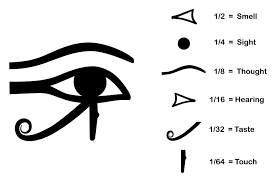
64 objective aspects? Good or bad? ''East is a beginning - west its ending.''
''The origin of the name Min {Menu} is unknown, Plutarch claimed it meant 'that which is seen', due to the similarity of the Egyptian verb 'to see'....'' [Page 21 'Ancient Egypt' / May-June 2023].
Other associations: ''He who raises his arm in the east.'' / ''Lord of the foreign lands'' / ''First chapels in Eastern Desert devoted to Min were rounded platforms at Mersa Gawasis. Many fragments found of Lambis Lambis {spider conch} linked to Min.'' / ''Like Pan, worshipped in the crevices of rocks, and at water sources.'' [page 22].
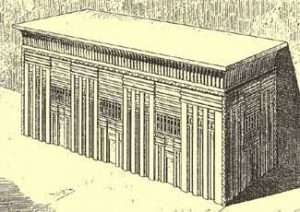
Unconscious = 'shadow' = ''recesses'' = 'crevice'?
Continued: ''It was said that a spear standing upright at the tomb of Christ would cast no shadow at midday, because it marked the center point of everything under the sun...."
Question. Where along the Nile River is NO SHADOW cast at midday?
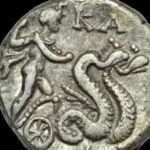
Two snakes?
Regardless of those first impressions - one eventually begins to 'see' - {within a study program} - what is associated with ''south''. Question. What would be associated with ''north''. And why? You could say - why bother? Because understanding the parts with the whole not only defines the mind set of our ancestors {in ALL cultures} - but gives clues as to a 'direction' = to someones most likely burial 'spot' {i.e., landscape symbolism}.
Question. In Africa all three TROPICS can be accessed {anywhere else?}. Tropic of Cancer, Tropic of Capricorn and the Equator. Orion is 'seen' upside down in the Southern Tropic. Right way up in the Northern one {'back to front'?}. Did the Egyptians know this and would it have been used within its mindset? In other words where 'inbetween' does Orion make that shift - to right himself?
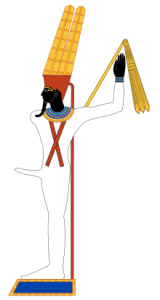
Egyptian Min or the Roman Pan.
For a further head scratch put "gathered" and "transcendent" in the usual box. It also explains the Cyanean Rocks and its use in that most famous of Greek myths [and therefore the subject as a whole]. A pair of rocks 'subdued' by a 'dove' - its tail feathers - only 'affected'. Recall what the 'dove' represents. The 'tail' end of something begins the process of something else. Something of the 'above' being an 'aid' to something below. Represented in the [macro] case as the division between two 'differing' continents - just as the ''Ha Ha'' lawn [micro] represents the division between higher/lower. ALL the above enclosed within the journey 'upon a sea or river'. Cattle 'strait' or divide - common to both. [Look up ''Bosphorus'' /wikipedia as well as ''ha ha''].

Gemini {the twins}. Gate?
Side note: "Hercules first appears in legend as a pastoral sacred king and, perhaps because shepherds welcome the birth of 'twin lambs', is a twin himself...a 'spear' armed twin....The priests of the Egyptian Thebes, who called him 'Shu', dated his 'origin' to 17,000 years before the reign of king Amasis…. His symbols are the acorn, the rock-dove - which nests in oaks as well as clefts in rocks - the mistletoe and the serpent." [Page 125 'The White Goddess'].
And/or: The fire destroyed the roof and the spire, but they are being rebuilt to look exactly as they did before. To do this, workers needed 1,200 oak trees, which were carefully chosen from forests across France. The trees were used to recreate the wooden framework of the roof, known as “the forest.”
''seventeen'' link?
''Rock of ages cleft for me, let me hide myself in thee...''
"Twice born?"
''Tail feathers'' in relation to 'unknown' BUT once a 'known' quantity {''quality''?} then those feathers become {plumes?} on top of the head. Hence:
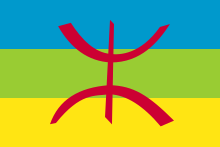
Berbers. Primary colours?

{Pisces}. Curved and straight lines as a means....?
The Symplegádes or Clashing Rocks, also known as the Cyanean Rocks, were, according to Greek mythology, a pair of rocks at the Bosphorus that clashed together whenever a vessel went through. They were defeated by Jason and the Argonauts, who would have been lost and killed by the rocks except for Phineus' advice. Jason let a dove fly between the rocks to see exactly how fast they'd have to row to beat the rocks; the 'dove' lost only its tail feathers. The Argonauts rowed mightily to get through and lost only part of the stern ornament. After that, the Symplegades stopped moving permanently.'' [Wiki].
"Dove" = 'peace offering'.

Return?
And/or: The Symplegades are sometimes identified with (or confused with) the Planctae or Wandering Rocks, which are mentioned in the Odyssey and Apollonius of Rhodes' Argonautica. In Apollonius's telling, the Symplegades were encountered on the way to the Golden Fleece and the Planktai were encountered on the return voyage.''
''Golden fleece'' in relation to sheep/rams/shepherds etc. Something ''unknown'' becoming a known quality. All as a means...?
Try ''17'' to understand why?
"Place of Rowing".
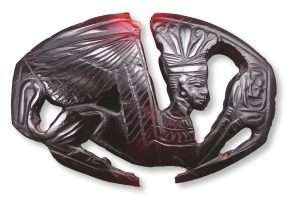
A sard plaque showing Tiye as a winged female sphinx with the cartouche of Nebmaatra. The headdress, with foliage, is identical to other female sphinxes from Western Asia. Right hand raised.
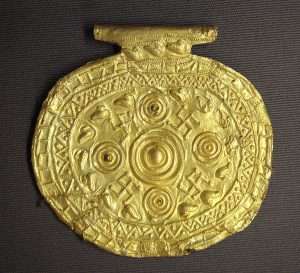
Ducks?
A working example: "In the same way as the temple in Middle Egypt, the temple at Sedeinga was called Ta-hut-Ty ‘the house or mansion of Tiye’. This later became Atiye, and Adey, in Meroitic and early modern times. The Meroitic temple in the town was dedicated to Isis, reflecting its origin in a temple dedicated to Hathorian goddesses. The ruins of the temple were dismantled by the French team who have been working at the site for many years, and the blocks are therefore easily accessible. The early travellers who visited the site could record only a few elements and the standing Hathor-headed column....
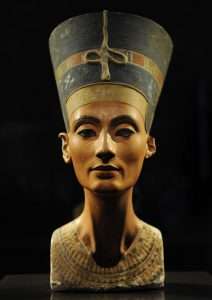
'Stamp of the feminine'. Real or symbolic?
The team led by Richard Lepsius published one significant image: the lintel with Tiye as a sphinx, wearing the flat-topped crown generally associated with Nefertiti, and certainly identifying Tiye with Tefnut. The other imagery on the panel is Hathorian: rearing uraei and the full face of Hathor on the sign for gold. Tefnut is the violent aspect of Hathor in the form of the burning Solar Eye, sent out to destroy humankind. A dedicatory inscription on a column states that the king made the temple for the ‘Great of Dread and Mistress of all Lands’.
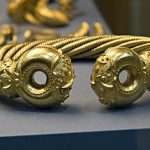
Cable-tow to enlarge.
The word neret means a vulture, but by extension also ‘fear’ and ‘dread’, and here clearly relates to the awe and dread inspired by Tiye as the manifestation of the Solar Eye....
The influence of the iconography and divine associations of Tiye continue through later Egyptian history. At the end of the Twentieth Dynasty, in the Khonsu temple at Karnak, Nodjmet appears as a female sphinx with elaborate headdress, again on the prow and stern cabins of the boat that tows the Barque of Mut. The iconography of the god’s wives of Amun of the Kushite and Saite Periods also follows that of Ahmose-Nefertari and Tiye, and their titles closely associate them with Tefnut. The same iconography is revived again for Ptolemaic queens, some of whom could also be said to have ‘filled the foreign lands with dread’."
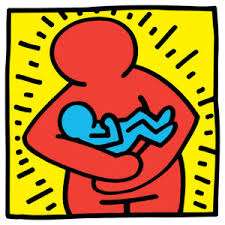
Manger = right or wrong 'sense' {of the word}.
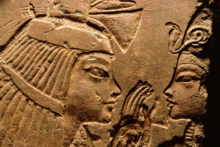
Tut with nurse. Any manger?
Something to ponder on: ''But from the time she grew with 'child' she went mad. Lady Charlotte says: ''became wild, and wandered about'' without coming near a dwelling. When her time came upon her, her right SENSE came back to her, it came in a place where a swineherd was keeping a herd of swine, and through terror of the swine the queen was delivered. And the swineherd took the boy until he came to court. And the boy was baptized, and the name Culhwch given to him because he was found in a pig run. Nonetheless the boy was of gentle lineage: he was first cousin to Arthur. And the boy was put out to nurse.''{Page 8 'A Celtic Quest' / J. Layard}.
''Wandering'' in relation to ''cursus'' {i.e., it could be ecliptic - therefore 'planet' link} and/or ''wandering rocks''.
Delos?
{C}aroline?
 Continued: Example {of same?} - from someone who is aware of this subject..."It is important to state unambiguously that our data are not in conflict with ''science,'' as the naive will imagine - in fact, we will provide several scientific explanations for all of it - but it is, grotesquely and awkwardly, in total conflict with common sense. It is perverse, paradoxical and preposterous. One might say, ''its damned funny," and if a child asked innocently, ''Do you mean 'funny ha ha' or 'funny peculiar'?" I'd have to say, ''Both." [Extract from the book by R. A. Wilson]. Try ''simultaneously'' {intent of}, i.e., in relation to a 'eureka' moment.
Continued: Example {of same?} - from someone who is aware of this subject..."It is important to state unambiguously that our data are not in conflict with ''science,'' as the naive will imagine - in fact, we will provide several scientific explanations for all of it - but it is, grotesquely and awkwardly, in total conflict with common sense. It is perverse, paradoxical and preposterous. One might say, ''its damned funny," and if a child asked innocently, ''Do you mean 'funny ha ha' or 'funny peculiar'?" I'd have to say, ''Both." [Extract from the book by R. A. Wilson]. Try ''simultaneously'' {intent of}, i.e., in relation to a 'eureka' moment.
Example of same {from 'unknown' point of view, i.e., someone who does not know}..."We are drowning in a sea of selfishness, ugliness and misery. There are to many crashing waves in this world, and not enough rocks to stall them. You have to paint your own piece of heaven to get through the days and stay afloat. I want to stay." [Extract from the book by Q. S. Lam].
Recall what ''seas'' and ''rocks'' represent.
Eastern way / Western way - but with a common aim in mind. Anything?
Side note: Not - ''The'' Western Way - i.e., general specific. One could say therefore that the common factor between the two {i.e.,East and West} is the word 'esoteric'.
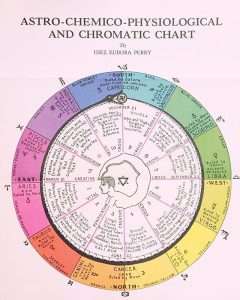
Head/Feet = Aries/Pisces?
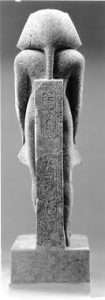
long or short?
"The idea of the intercession of the 'virgin' to protect the 'sinner' {link to ''fall''} from the consequences of same; in an after-world 'hell' plays a dominant role in the Divine Comedy of Dante. This master piece of the high middle ages provides a sequential mystery system that is the Western equivalent of the highest flights of Tibetan Mahayana Buddhism. Indeed it would be possible to produce a profound synthesis of Eastern and Western symbolic mysticism by a parallel analysis of 'The Divine Comedy' and 'The Tibetan Book of the Dead'." [Extract from the book by G. Knight].
As an example {'Eastern}...'"Sanskrita = ''polished, complete." Sanskrit is the elder sister of all Indo-European tongues. Its alphabetical script is called Devanagari; literally, ''divine abode.'' - "Who knows my grammar knows god." Panini, great philologist of ancient India, paid that tribute to the mathematical and psychological perfection of Sanskrit. He who would track language to its lair must indeed end as omniscient." [Extract from the book on Paramahansa Yogananda]. Try ''logos'' and then find its ''alternative'' equivalent.
{'Western'}... The blacksmith being the older brother of the shaman. Think about both in relation to 'younger'. Enlarged elsewhere i.e., one relates more to top-down.
Hewn / UNhewn?
Gendry? {Game of Thrones}.
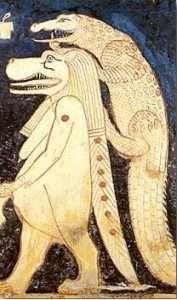
Teeth and Tongue. Victory from the jaws of defeat?

'Spirit' or 'Soul'? Male or female feet.
A [practical?] example..."This evening Bhaduri expounded various philosophical points connected with the life of Mirabai, a medieval Rajputani princess who had abandoned her court life to seek the company of saints. One great sannyasi, Sanatana Goswami, refused to receive her because she was a woman; her reply brought him humbly to her feet. 'Tell the master,' She had said, 'that i did not know there was any Male in the universe save God; are we all not females before him?' [Same book]. AS is...
"All the celebrated songs of India have been composed by devotees of the 'divine'. The Sanskrit word for ''musician'' is bhagavathar, - ''he who sings the praises of god."...Because man himself is an expression of the Creative Word..." try ''logos'' to see it from a different 'angle'.
Question. shadow and/or anima/us - as a start point? Question 2. A start point of what?
 "Babaji's spiritual state is beyond human comprehension." Sri Yukteswar explained to me. ''The dwarfed vision of men cannot pierce to his transcendental 'star'. One attempts in vain even to picture..." [Same book].
"Babaji's spiritual state is beyond human comprehension." Sri Yukteswar explained to me. ''The dwarfed vision of men cannot pierce to his transcendental 'star'. One attempts in vain even to picture..." [Same book].
Hephaestus link {and/or therefore ''lame''}?
"In his {i.e.,C. Jung} book 'Modern Man in Search of a Soul', he claims that modern man is somehow fascinated by the almost pathological manifestations of the unconscious mind. Much of the efforts of the serious occultist are in fact directed towards a controlled exploration of precisely this area. The hallucinogenic drug cult is, essentially, an undisciplined attempt to do the same thing, but uncontrolled..." [From the book 'The Fourth Dimension: A Christian Approach to the Occult' by A. Duncan].
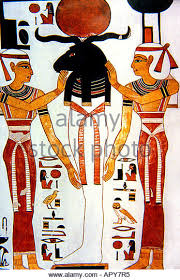
Question. Anima OR Animus - it can only be one or the other. ISIS/HORUS/OSIRIS myth, remember is non gender specific - it has to be - if it applies to ALL individuals. Question 2. Fable or myth or something else?
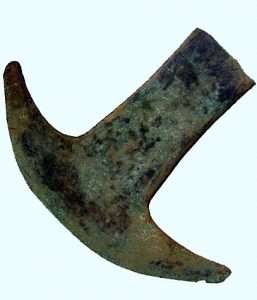
'T' shapes. Aztec Hoe 'money'. Can also be seen on the external sides of the Sarsen Stones. Very similar shape can be seen being WORN as an earring in the LEFT ear of Nefertari. That same shape that can be seen as the entrance {'gateway'?} to her tomb in the Valley of the Queens.
Egyptian equivalent..."In this same tomb {i.e.,Nefertari / valley of Queens / Thebes}, on the back face of the wall on which Re-Horakhty and Hathor are painted, a very rare scene is found picturing a ram-headed mummy {i.e.,horizontal curved horned ram peculiar to Amun} - between Isis and Nepthys, accompanied by the text: 'It is Re who rests in Osiris; it is Osiris who rests in Re.' The few texts which refer to this scene say only: 'Secret, Mystery, it is Re, it is Osiris.' Might not this image - uniting in one figure, these two great principles - be referring to the mystery of redemption of ultimate liberation?" [Extract from the book 'Egyptian Mysteries' by L. Lamy].
"...the anima appears in 'her' proper positive role - that is, as a mediator between the ego and the self." ['Man and his Symbols' / C. Jung].
Question. Could not the same be implied with the word ''animus'' in relation to the sentence beginning with ''mediator'' ?

Hatshepsut {with beard}: ''Foremost of the Noble Women.''
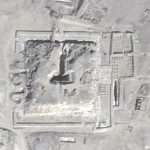
''Son of'': Upside down?
A working example: ''Jesus said, look, i will guide her to make her male, so that she too may become a living spirit resembling you males. For every female who makes herself male will enter the kingdom of heaven.'' ['Gnostic Gospel
of Thomas' / verse 114].
''Eighteen'' to enlarge.
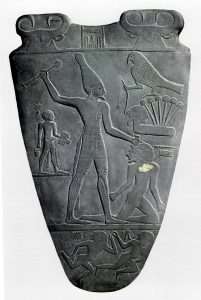
'Flat' sides. Heart shape. Owl in the 'horizontal' position within that 'little' ''T'' shape. Lintel?
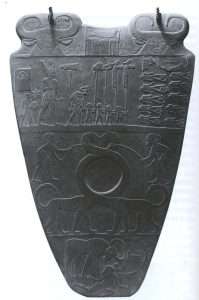
Narmer Palette. 'T' shape between the horned cow heads. On BOTH sides. Large ears. 'Barber' to enlarge.
An 'alternative' viewpoint...The concepts of 'iron' and 'blacksmiths' very important. As indicated in chapter eight of 'Hamlets mill'. The ‘forging’ of something. The blacksmith being the older brother of the shaman. Think about it in relation to the 'younger'. Enlarged elsewhere.
Shadow and/or Anima...as a representation of something. The 'beginnings' of something. Question. Which and why?
Side note. Oasis of Siwa . Amun related. 'Father' of all the gods. And/or Alexander visited it {oracle} before becoming 'Pharaoh'.
Question. Aries {ram} Taurus {bull} = ''back to back''? OR Pisces/Virgin? {i.e., as opposite 'ends' on the same pole} - as a means...?
As seen from a different perspective: "One of these utterances is this: "Adam and Eve were at first 'created' as one being, having their 'backs' united; they were then separated, and one half was removed, and brought before Adam as Eve''...."Note also how clearly it has been stated that Adam and Eve were two in some respects, and yet they remained one, according to the words: 'Bone of my bones, and flesh of my flesh' {Gen.ii.23}.…" [Page 216 'Guide for the Perplexed'].
Try ''Naked'' and ''Garment'' symbolism to take something further beyond {horizon?} the obvious.
A {working?} example {i.e., if only in the Old Testament sense of the 'word'}: "I will deliver thee into the hand of them that thou hatest, into the hand of them from whom thy mind is alienated. And they shall deal with thee hatefully, and shall take away all thy labour - and shall leave thee naked and bare...." [Ezekiel 23:29].
Try Gog/Magog.
REFRESHER..."There is a very interesting book by Dr M. Harding called 'Woman's Mysteries Ancient and Modern'. In it is an immense amount of information which should set the readers subconscious mind questing to and fro on a scent which grows warmer and warmer until Chapter 15 is reached. What Chapter 15 means to you will depend entirely upon what you are. It is true this work deals almost entirely with the Moon Mysteries, but, a mans immediate inner self - his anima - is feminine...whereas in this state of cosmic matrimony...for a woman that would be her animus; not anima; if Jung is correct." [Chapter 5, 'The Forgotten Mage'. Enlarged elsewhere].
Side note. 15th in early spring = the beginning of 'Passover'. Enlarged elsewhere.
And/or: 15 = ''twelve'' {zodiac?} + ''three''?

'Triples'?

Isle of Wight flag.
Greek equivalent of something..."There are a number of 'triple' facets to this myth {i.e.,Persephone/Demeter in relation to 'Hades'} - that throw light upon the meaning of the tale. Let us first examine the Three Goddesses in the opening scene sporting themselves in the meadows of the Nysaean fields. They are Athene, Artemis and Persephone - three virgin goddesses. These are the 'virgin' facet of the Goddess further split. The nature of the three facets is complementary; although they all share this element of virginity, it is very different in each case. In Athene's case, virginity can be seen as arising out of her virago nature, her incorporation of the masculine within herself. Athene does not need contact with the masculine. She personifies the wisdom facet of the 'Goddess'. Artemis virginity is somewhat different, she is the wild 'virgin' of the hunt, the feminine immersion in the..." [From the book 'The Triple Goddess' by Adam McLean. All emphasis, this readers].
"Born {Athene} from the forehead of Zeus''. See it? As a means...?
Artemis 'hunting' for what. Animus?
And/or..."Zeus-Dionysos, the precursor of both Greek gods on Crete, changed his 'form' as he passed through the three phases of his myth, which are comparable to the acts of a drama {Feast of Fools link?} that 'reproduced' himself. The three phases and acts correspond to the three phases of zoe, or life, which in the Dionysos myth is masculine in its relation to women." [From the book by C. Kerenyi. Mentioned elsewhere].
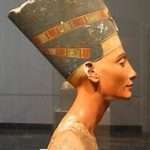
''Tower'' shape?
Hence the link to..."Throughout its development the Dionysian cult preserved the character it had when it first entered into history. With its sensuality and its emphasis on 'sexual' love, it presented a marked affinity to the feminine nature, and its appeal was primary to women; it was among women that it found its most loyal supporters...Dionysus is a women's god in the fullest sense of the word, the source of all women's sensual and transcendent hopes, the 'center' of her whole existence. It was to women that he was 'first revealed' in his glory, and it was women who propagated his cult and brought about its triumph." [Same book. Emphasis, this readers].
Animus?
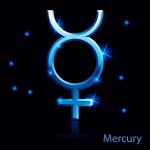
To sublimate. Before/after or After/before?
From a different perspective: ''....Remember how holy women followed Jesus ....and ministered to Him of their substance, and how the three Marys stood before the cross and especially how Mary Magdalene - called the tower - saw the risen Christ first of all before the apostles...'' [Page 88 'Mary Magdalene: Insights from Ancient Magdala / J. Ristine].
And/or: Before/After...as a means...?
And: ''She had a task, one commissioned by an 'angel' {higher?}, according to Mark's account. 'Go, tell his disciples and Peter: He is going AHEAD of you into Galilee. There you will see him, just as he told you.'' [Page 75].
'His Majesty, Queen Hatshepsut' / Dorothy Sharp Carter.
Brienne of Tarth? {Game of Thrones}.
Understanding that question/answer {if correct} - gives clues {possible directions?} in attempting to ''get ones head'' around the following:
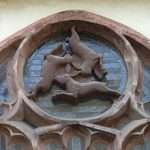 "As I have said, this circle is an ancient symbol of protection....mirrored in the movements of the Sun, Moon, and stars - the cycles of seasons and re-birth. Around it revolve the Four Symbols of the Tuatha, or 'portals' ….gates of the elemental 'otherworlds' {''domains''?}….aligned to the four corners of the earth: an altar of cold stone to the North, a fiery Oak to the South, fragrant Golden Pipes to the East, and then the dark Western Waters. And above it all, lies the vastness Nwyvre of 'space', through which the three illuminating Rays of Awen {Ain Sof?} are cast forth by the 'Sun'. And below; below that the depths of Annwn: that indigo, hidden realm of creation - into which no women may look." [ '21 Lessons of Merlyn: A Study in Druid Magic and Lore'].
"As I have said, this circle is an ancient symbol of protection....mirrored in the movements of the Sun, Moon, and stars - the cycles of seasons and re-birth. Around it revolve the Four Symbols of the Tuatha, or 'portals' ….gates of the elemental 'otherworlds' {''domains''?}….aligned to the four corners of the earth: an altar of cold stone to the North, a fiery Oak to the South, fragrant Golden Pipes to the East, and then the dark Western Waters. And above it all, lies the vastness Nwyvre of 'space', through which the three illuminating Rays of Awen {Ain Sof?} are cast forth by the 'Sun'. And below; below that the depths of Annwn: that indigo, hidden realm of creation - into which no women may look." [ '21 Lessons of Merlyn: A Study in Druid Magic and Lore'].
Yezidis?
And/or: ''While it would be a gross simplification to identify the Native Tradition with the feminine, and the Hermetic with the masculine, there is a symbolic truth to be uncovered here." Enlarged elsewhere.
''Esoteric is an adjective originating in Greece; it comes from the Greek ἐσωτερικός esôterikos, from esôtero, the comparative form of ἔσω esô: "within." Esoteric refers to anything that is inner. Its antonym is exoteric, from the Greek ἐξωτερικός eksôterikos, from eksôtero, the comparative form of ἔξω eksô: "outside." Plato, in his dialogue Alcibíades (circa 390 B.C.E.), uses the expression ta esô, meaning "the inner things," and in his dialogue Theaetetus (circa 360 B.C.E.) he uses ta eksô, meaning "the outside things." The probable first appearance of the Greek adjective esôterikos is in Lucian of Samosata's "The Auction of Lives," § 26 (also called "The Auction of the Philosophical Schools"), written around 166 C.E.
The term esoteric first appeared in English in the 1701 History of Philosophy by Thomas Stanley, in his description of the "Auditors of Pythagoras." The Pythagoreans were divided into "exoteric," which were under review, and "esoteric," which had performed well enough to be admitted into the "inner" circle.''
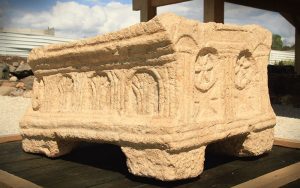
Found in the birth place of Mary Magdalene. 'Fire' wheels 'in profile' ? Chariots of the Gods?
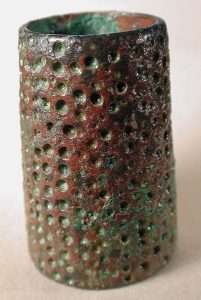
Thimble. Tom thumb to enlarge.
"The trickster is the same in all cultures. He visits the ''forbidden territory'' of the gods, steals something, and brings it out to benefit mankind. Often the invention he brings us is the wheel, either for spinning thread or making fire. The Greek Prometheus visited 'heaven' and brought back the 'secret' of making fire. His name may come from the Sanskrit pramantha, the swastika or fire-wheel. The fire-wheel is, in many myths, the masculine form of the feminine spindle." [Page 77/8 'Arachne Rising: The Search for the Thirteenth Sign of the Zodiac' / J. Vogh].
Weaving 'garments' in relation to 'nakedness'?
Ariadne/Dionysus ?
Wheelhouse?
-
1 ''A part of a boat or ship serving as a shelter for the person at the wheel.''
-
2. ''One's area of interest or expertise."as the campaign swings to the south, that should be right in his wheelhouse"

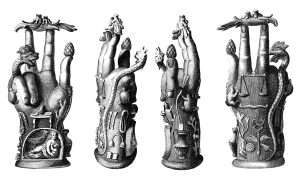
The hand of Sabazios {Gordian knot fame}. Thumb = pinecone?
A side step..."In the heart center, there is a lotus. Each petal of this lotus has its own quality: desire, anger, infatuation, greed, love, modesty, knowledge, detachment, joy, omniscience, etc. Within the heart is a space the size of a thumb, and here a divine light shimmers. The sages have spent their lives 'looking' at this light. How marvelous is the heart center! How magnificent is the light in the heart space! How divine is the goddess Kundalini! As she 'unfolds', mans entire being is 'transformed.'' [Chapter one, 'Play of Consciousness'. Mentioned elsewhere].
Try ''unfold''.
From shadow to anima {or would that be - the joining of the 'two'?}. Unknown to becoming known. Representational of. Anything? Try ''unfold''.
'The Woman Who Married Herself' :{Radio BBC World Service /30th December 2018].
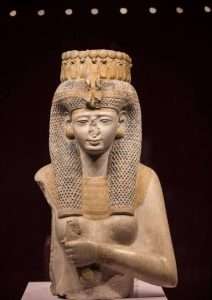
Meritamun.
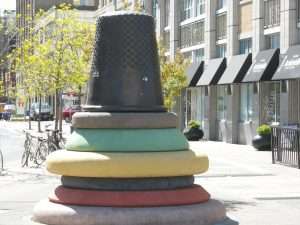 From a different perspective: "....the focus of spiritual initiation and evolution were related as an ''unveiling of Isis''....The reference to being ''conceived'' through the goddess is a clear relation to ''divine birth'' i.e.,to be ''born again''....It is also a reference to the 'Serpent Power'. Isis and sister are the goddess of the serpent power. Being 'born' of them means being born of elevated consciousness....which is the innate life force, latent in every human being." [Page 191 'Egyptian Book of the Dead' / M. Ashby].
From a different perspective: "....the focus of spiritual initiation and evolution were related as an ''unveiling of Isis''....The reference to being ''conceived'' through the goddess is a clear relation to ''divine birth'' i.e.,to be ''born again''....It is also a reference to the 'Serpent Power'. Isis and sister are the goddess of the serpent power. Being 'born' of them means being born of elevated consciousness....which is the innate life force, latent in every human being." [Page 191 'Egyptian Book of the Dead' / M. Ashby].
Think about it in relation to that ''universal bit''.
Side note: ''Thimble is derived from the word thumb.''
'Weaving' link?
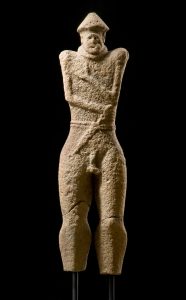
'Naked' / 'Garment' to enlarge. Question. What would the remedy be to readdress a balance? 'Scabbard'?
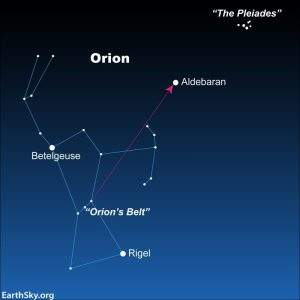 A work in progress: The warrior of Hirschlanden has a disproportionately small head, with a face almost weathered away, high shoulders, skinny arms, and legs that can only be described as hefty. But unlike the Glauberg {warrior} Prince, he is practically naked. He wears a conical {'triangular'} hat, a neck ring and a belt. And the dagger stuck diagonally in the front of his belt {'middle'} does nothing to distract from his large, erect penis. I think we get an interesting insight into modern culture from the fact that many descriptions of this statue in scholarly works barely mention the genitalia, and if they do, they are delicate about it, using the rather obscure term ithyphallic.'' [Page 196 'The Celts'].
A work in progress: The warrior of Hirschlanden has a disproportionately small head, with a face almost weathered away, high shoulders, skinny arms, and legs that can only be described as hefty. But unlike the Glauberg {warrior} Prince, he is practically naked. He wears a conical {'triangular'} hat, a neck ring and a belt. And the dagger stuck diagonally in the front of his belt {'middle'} does nothing to distract from his large, erect penis. I think we get an interesting insight into modern culture from the fact that many descriptions of this statue in scholarly works barely mention the genitalia, and if they do, they are delicate about it, using the rather obscure term ithyphallic.'' [Page 196 'The Celts'].
''But what did those Iron Age people believe about the world around them? What deities did they worship, and what stories did they tell each other around the fire? They seem like impossible ideas to GRASP hold of, especially when talking about a society that was pre-literate for so much of its existence....Thoughts and beliefs do not fossilize. Our species has existed on this planet for some 200,000 years, but for the vast majority of that time, we have no idea what people thought, or what stories they told each other. We simply dont know what they belived about their own origins or the world in which they lived, nor do we know what sort of natural and supernatural explanations they came up with for their experience of the world - of birth, death and everything inbetween.'' [Same book].

'Fire' and water. Which and why?
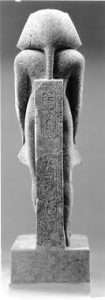
Princes Daughter?
And/or: ''In ancient times, Akhmim was called Ipu and was the capital of the ninth nome of Upper Egypt. It was a place of worship to the ithyphallic god Min, and a center for weaving, as it still is today. The wealthy, but non royal family of Queen Tiye of the Eighteen{th} Dynasty are believed to have come from Akhmim....And many discoveries have been made linking Ramses II to it. At least one large temple - of which the only parts visible to the general public are the two raised colossi of the king and his daughter {and Great Royal Wife} Meritamun, located in their own OPEN AIR museum.'' [Page 52 'Ancient Egypt' / July-August 2023].
''Min's cult began and was centered around Coptos (Koptos) and Akhmim (Panopolis) of upper Egypt,[4] where in his honour great festivals were held celebrating his "coming forth" with a public procession and presentation of offerings.[2] His other associations include the eastern desert and links to the god Horus. Flinders Petrie excavated two large statues of Min at Qift which are now in the Ashmolean Museum and it is thought by some that they are pre-dynastic. Although not mentioned by name, a reference to "he whose arm is raised in the East" in the Pyramid Texts is thought to refer to Min.''
And/or: ''The Canary Islands, a Spanish archipelago off the coast of northwestern Africa, are rugged volcanic isles known for their black- and white-sand beaches. Tenerife, the largest island, is dominated by the sometimes-snowy active volcano Mt. Teide, which has its own astronomical observatory and is part of Teide National Park. Tenerife hosts a huge pre-Lent Carnival in the capital, Santa Cruz de Tenerife.''

A goaty?

The hand of Sabazios. Thumb = pinecone?
A working example: ''Fionn mac Cumhaill (/ˈfɪn məˈkuːl/ FIN mə-KOOL;[a] Old and Middle Irish: Find or Finn[1][2] mac Cumail or mac Umaill), often anglicized Finn McCool or MacCool, is a hero in Irish mythology, as well as in later Scottish and Manx folklore. He is the leader of the Fianna bands of young roving hunter-warriors, as well as being a seer and poet. He is said to have a magic thumb that bestows him with great wisdom. He is often depicted hunting with his hounds Bran and Sceólang, and fighting with his spear and sword. The tales of Fionn and his fiann form the Fianna Cycle or Fenian Cycle (an Fhiannaíocht), much of it narrated by Fionn's son, the poet Oisín.''
'To stick out like a sore thumb'.
''Swollen/Swell'' to enlarge.
'Bruise'?
''There was an old man named Michael Finnegan He had whiskers on his chin again.''
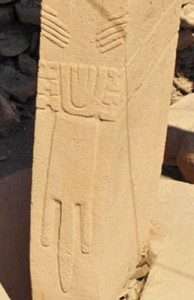
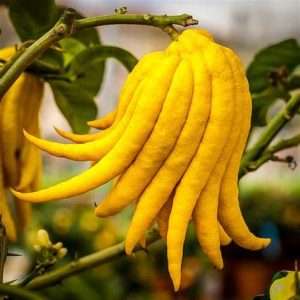
Citrus medica var. sarcodactylis, or the fingered citron, is an unusually-shaped citron variety whose fruit is segmented into finger-like sections, resembling those seen on representations of the Buddha. It is called Buddha's hand in many languages including English, Chinese, Japanese, Korean, Vietnamese, and French.
Side note: ''It is a remarkable bit of irony, the finger: venerated, kept in a shrine, subjected to the same treatment as a saintly relic. But this finger belonged to no saint. It is the long bony finger of an enemy of the church, a heretic.
As with a fine wine, it took some years for Galileo’s finger to age into something worth snapping off his skeletal hand. The finger was removed by one Anton Francesco Gori on March 12, 1737, 95 years after Galileo’s death. Passed around for a couple hundred years it finally came to rest in the Florence History of Science Museum, which has since become the Galileo Museum.
In 2009 two more fingers and a tooth belonging to Galileo were discovered at an auction. The spare parts had disappeared in 1905, not seen for 100 years. But then the purchaser was able to deduce their origin, and has returned them to the Science Museum where they match a detailed description from when they were last seen.
Today the middle finger sits in a small glass egg among lodestones and telescopes, the only human fragment in a museum devoted entirely to scientific instruments. It is hard to know how Galileo would have felt about the final resting place of his finger. Whether the finger points upwards to the sky, where Galileo glimpsed the glory of the universe and saw God in mathematics, or if it sits eternally defiant to the church that condemned him, is for the viewer to decide. Galileo’s middle finger has since been joined by his index finger, thumb, and tooth enclosed in a bell jar.'' ['Live Science'].
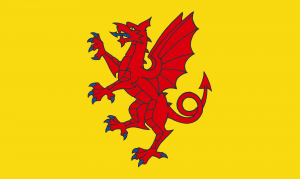
"Dragon Lord!'' he spoke, "The 'Sun' has risen in the West {S/W ?}." Try ''Sirius'' to see it from the ''geocentric'' point of view. AND/OR: ''Venus rotates backward on its axis compared to most planets in our solar system. This means the Sun rises in the west and sets in the east, opposite of what we see on Earth.''
 Analogy of same principle?..."This little man, the size of a thumb, is the 'Ishon' of the Hermetic and Old Testament texts. The man the size of a thumb, resides in the midst, within the self, of the past and future....the Tom thumb of fairy tales, this inner dwarf or 'Ishon' which is prepared to 'reveal' things that are normally hidden......is meant to symbolize an esoteric aspect of Spiritual development....the fool has to learn from the 'smaller' inner man....It is worth bearing in mind that, in materialistic terms, the inner man must be smaller than the outer man. This inner man is linked with the spine, which in itself is linked with the staff...This symbolism applies to the staves in the hands of the Tarot Fool: one staff is the spine of the outer fool, the other that of the inner fool." [Bibliographic notes to chapters 4, and 7, of the book 'The Zelator']. Question. anima or shadow aspect?
Analogy of same principle?..."This little man, the size of a thumb, is the 'Ishon' of the Hermetic and Old Testament texts. The man the size of a thumb, resides in the midst, within the self, of the past and future....the Tom thumb of fairy tales, this inner dwarf or 'Ishon' which is prepared to 'reveal' things that are normally hidden......is meant to symbolize an esoteric aspect of Spiritual development....the fool has to learn from the 'smaller' inner man....It is worth bearing in mind that, in materialistic terms, the inner man must be smaller than the outer man. This inner man is linked with the spine, which in itself is linked with the staff...This symbolism applies to the staves in the hands of the Tarot Fool: one staff is the spine of the outer fool, the other that of the inner fool." [Bibliographic notes to chapters 4, and 7, of the book 'The Zelator']. Question. anima or shadow aspect?

'Domesticated'?
A working example: ''I had 'Tame Impala' in my head before the chose of answers came up....My FIRST INSTINCT was 'Tame Impala' and i think it would be rude to ignore it. So i will choose Tame Impala please.'' [Conner: In answer to the question: ''Released in 2020, 'The Slow Rush' is the fourth studio album by which Australian act?'' / 'Tipping Point' / ITV / 2021].
N.B. Athene ''Born from the 'head' of Zeus''
From a different perspective: ''But I, although slighted Because I was not big, Fought trees, in your array, On the field of Goddeu Brig.''
'Lame'?
The above verse - the final one - in the Irish 'epic' the Battle of the Trees' what the author R. Graves defines as: 'what seems to have been the most important religious event in Pre-Christian Britain'.
Refresher: "A seed sized {Oak?} portion of the stone of inner effort will transform an enormous amount of leaden inertia."
 ''The 'I' who was slighted because he was not big is Gwion himself. whom Heinin and his fellow bards scoffed at for his childish appearance; but he is perhaps speaking in the character of still another tree - the mistletoe, which in the Norse legend killed Balder the Sun-god after having been slighted as too 'young' to take the oath not to harm him. Although in ancient Irish religion there is no trace of a mistletoe cult, and the same does not figure in the Beth-Luis-Nion; to the Gallic Druids who relied on Britain for their doctrine it was the most important of all trees, and remains of mistletoe have been found in conjunction with Oak branches in a Bronze Age tree coffin in Yorkshire. Gwion may therefore be relying here on a British tradition of the original 'Battle of the Trees' rather than his Irish learning.'' [Page 40/8 'The White Goddess'].
''The 'I' who was slighted because he was not big is Gwion himself. whom Heinin and his fellow bards scoffed at for his childish appearance; but he is perhaps speaking in the character of still another tree - the mistletoe, which in the Norse legend killed Balder the Sun-god after having been slighted as too 'young' to take the oath not to harm him. Although in ancient Irish religion there is no trace of a mistletoe cult, and the same does not figure in the Beth-Luis-Nion; to the Gallic Druids who relied on Britain for their doctrine it was the most important of all trees, and remains of mistletoe have been found in conjunction with Oak branches in a Bronze Age tree coffin in Yorkshire. Gwion may therefore be relying here on a British tradition of the original 'Battle of the Trees' rather than his Irish learning.'' [Page 40/8 'The White Goddess'].
Try the title of either the book or ''battle'' to 'see' it in the bigger picture.
'Tyrion Lannister'? {Game of Thrones}.
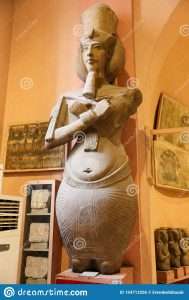
Dwarf?
Something extra: "The Hebrew 'Ishon' means 'dwarf', but in the authorized version of the bible it is translated as 'apple of the eye'. The association is almost certainly linked with the hermetic 'kore' [see part one]. In The Lamentations of Jeremiah [ii, 18], the translation offered is 'let not the apple of thine eye cease', suggesting that the apple of the eye is weeping. However, it could, with a much deeper meaning, be translated, ''let not the small man within cease.'' [Bibliographic notes to the final chapter].
'Waters of the Gap'?
Side note: The apple of discord starts the Trojan war.
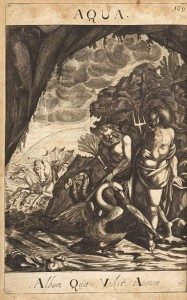
What does the 'Swan' represent? Where would it be placed {in say} a landscape?
Analogy of same? "Despite their compelling links to the Solutreans, the religious ideologies of the Swiderians have been more difficult to ascertain. The ancient rock art of the Russian Republic of Karelia, which borders Finland to the west, does, however throw some light on the matter. Close to the shores of Lake Onega - where in 1936 a nine thousand year old cemetery was found and identified as belonging to the post-Swiderian Kunda culture - exposed rock surfaces are covered in carved petroglyphs, many of which belong to the mesolithic age. Some show swans with exaggerated necks, like long poles. Others show swans sitting on the top of poles that are being climbed by a small human figure. As at Lascaux, the poles almost certainly symbolise axes mundi, while the human figures are perhaps the souls of shaman travelling between the physical world and sky world. This suggest that the Swiderains, like the Solutreans before them, saw birds, and swans in particular, as symbols of a sky world reached by way...[ From the book 'Gobekli Tepe' by A. Collins. Emphasis, this readers].

Long neck? Apple of someones eye?
Question. When ALL the available information is assessed what is the most likely reason for taking an interest in such ''religious ideologies.'' i.e., that first yet last subject OR just the fear of comets? Try ''swans neck'' amongst others.
'Spotless'?
"The waters of the Gap: [key] The Mythology of Aquae Sulis' by R. Stewart.
''The 'eyes of the soul' - are what we call in modern Hermeticism the 'lotus flowers' or simply 'lotuses', and what Hindu yoga names 'chakra centers' or 'chakras'." [Quote taken from the book by Tomberg]. Put together with Eastern equivalent of the intent of ''logos.''
Side note: ''The moon is so big that Pluto and Charon are sometimes referred to as a double dwarf planet system. The distance between them is 12,200 miles (19,640 km). The Hubble Space Telescope photographed Pluto and Charon in 1994 when Pluto was about 30 Astronomical Units (AU) from Earth.''

Eastern equivalent. Can you see it? Question. Coincidence or a meaningful one? WHY GO TO ALL THIS EFFORT?
Continued: "The infinite potencies of sound derive from the Creative Word, Aum, the cosmic vibratory power behind all atomic energies. Any word spoken [or understood] with clear realization and deep concentration [i.e.,and/or through study] has a materialization value [i.e.,a known quantity]. Loud or silent repetition [i.e.,''revision''] of inspiring 'words' [keys?] has been found effective in ...psychotherapy; the secret lies in the stepping up of the minds vibratory rate [as it does in whatever one is 'meditating' on - as a means to a learning curve - any learning curve]...The Aum vibration that reverberates throughout the universe [the ''word'' or ''voice of many waters'' of the Bible] has three manifestations or 'gunas', those of creation, preservation, and destruction. Each time a man utters a word he puts into operation one of the three qualities of Aum..." [Extract from the book 'Autobiography of a Yogi'. Emphasis and parenthesis; this readers]. Recall what those three ''qualities'' refer too. See Part 1 too refresh.
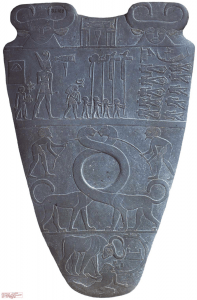
Long neck?
 Practical example:"... The thought process - and sometimes the practices and sequence of exercises or reading - that precede a 'mystical' experience can rarely be precisely recalled nor ordered. This makes for frustrating learning, although one builds up a sense of faith that the viewpoint is more important than the past journey. Frater P.P.E. had two such experiences in this light, the first of which was whilst at a place of employment. He was musing on some Kabbalistic conundrum and turned to look away from the window and at a red electric plug connected to a wall socket. At that moment, the red plug became real in a sense unlike anything he had experienced before. The whole of existence was present and correct in a timeless moment, before it slipped away back into the previous state of awareness. Perhaps there was something in the symbolism of being plugged in, or perhaps the colour red? These events are rarely repeatable. The second experience was when Frater P.P.E. was sitting on the floor at a manual typewriter, in the days when that counted as a wireless word processor with its own in built printer. He turned to pick up a piece of paper and was suddenly seized with an absolute knowledge of what the universe was for, what it intended, and how it all worked. This lasted for several seconds before again being replaced by everyday consciousness. Afterwards, there was some sense of it all being about friction and communication, but these hardly touched upon the actual experience. The initiation system is designed to promote these higher states and prepare the initiate to hold them for longer periods of time." [Extract from the book 'The Magister'].
Practical example:"... The thought process - and sometimes the practices and sequence of exercises or reading - that precede a 'mystical' experience can rarely be precisely recalled nor ordered. This makes for frustrating learning, although one builds up a sense of faith that the viewpoint is more important than the past journey. Frater P.P.E. had two such experiences in this light, the first of which was whilst at a place of employment. He was musing on some Kabbalistic conundrum and turned to look away from the window and at a red electric plug connected to a wall socket. At that moment, the red plug became real in a sense unlike anything he had experienced before. The whole of existence was present and correct in a timeless moment, before it slipped away back into the previous state of awareness. Perhaps there was something in the symbolism of being plugged in, or perhaps the colour red? These events are rarely repeatable. The second experience was when Frater P.P.E. was sitting on the floor at a manual typewriter, in the days when that counted as a wireless word processor with its own in built printer. He turned to pick up a piece of paper and was suddenly seized with an absolute knowledge of what the universe was for, what it intended, and how it all worked. This lasted for several seconds before again being replaced by everyday consciousness. Afterwards, there was some sense of it all being about friction and communication, but these hardly touched upon the actual experience. The initiation system is designed to promote these higher states and prepare the initiate to hold them for longer periods of time." [Extract from the book 'The Magister'].
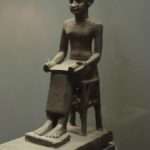 "...a timeless moment'' in relation to the working out of ''a conundrum'' regardless of subject. But the word ''mystical'' used because of its direct relevance to this subject, i.e.,its 'spiritual' value - its spiritual content. That final sentence could also be applied and to be seen as - general specific: i.e., ''Initiation'' in relation to a 'student' in the course of his/her studies through the course of a curriculum. The more one learns [regardless of subject] the more one exercises the mind; and therefore the more one is able to gain insights on those [''higher levels?''] of a learning curve - as an example - the value of an objective exercise when working out something of a hypothetical nature - gives the same result, i.e.,the 'value' [and/or meaning ] - of a conundrum. Yes or No?
"...a timeless moment'' in relation to the working out of ''a conundrum'' regardless of subject. But the word ''mystical'' used because of its direct relevance to this subject, i.e.,its 'spiritual' value - its spiritual content. That final sentence could also be applied and to be seen as - general specific: i.e., ''Initiation'' in relation to a 'student' in the course of his/her studies through the course of a curriculum. The more one learns [regardless of subject] the more one exercises the mind; and therefore the more one is able to gain insights on those [''higher levels?''] of a learning curve - as an example - the value of an objective exercise when working out something of a hypothetical nature - gives the same result, i.e.,the 'value' [and/or meaning ] - of a conundrum. Yes or No?
Francisco de Osuna author of 'The Third Spiritual Alphabet' defines the same {process?} as the 'path of recollection'.
Or in a more ''general specific'' manner - put those keys together, to understand what they imply relative to the self.
Proof..."The continuation - in fact, the concentration upon - the techniques is paramount. They provide the framework in which initiation takes place, and the foundation for further progress. They also provide an experiential language in which you can maintain orientation during later experiences." [i.e.,information gained - the parts within the whole -building blocks to build on - as all subject material proves - in one form or another- regardless of how or where it is obtained]. Same book.
The real question however, is the usual one. Why go to all this effort?
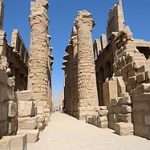
Karnak. ''Mountain low, Valley high.'' i.e., the middle/balanced Way. Senet board game?
REFRESHER: "There is a mosque whose foundation was laid from the first day on piety; it is more worthy of thy standing forth therein." [i.e., in relation to ''The original mosque of piety built by the Muhammad himself]..."Which then is best? - he that layeth his foundation on piety to God and his good pleasure? - or he that layeth his foundation on an undermined sand cliff ready to crumble to pieces?" [Quran 9:108/109].
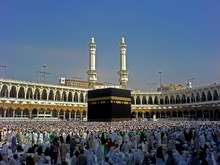
The Black Stone. A ''cubit'' one?
Islam equivalent,i.e.,practical application of above...."Then he joins the divine Name of the Ever living with the sixth Name - Qayyum, the Self - existing One upon whom all existence depends. This brings him to the Muzdalifa of the center of the heart {size of a ''thumb''?}." [Chapter 18, 'The Secret of Secrets'. Mentioned within]. In relation to the 'parts' enacted at Makka, relative to a 'journey'. That individual one. Hence the title of the chapter....' On the Pilgrimage to Makka and the inner Pilgrimage to the Essence of the Heart'. For information on the whole especially in relation to the 'movement' around the Ka'ba in answer to the question put forward in part one of this web page, put ''pilgrim'' {and/or 'fool' and 'peddler'?} in the usual box on all pages, especially 4. Then try ''bosom''- Before asking oneself - agree or disagree? Universal concepts? or just local ones?
Another analogy. Different 'keys' same principle..."Follow the living symbols through the meadows of inner vision as a child delighting in the random colours and smells and sounds of nature. You will find it has an inner logic and structure of its own. The Principles of discovery are the same on the inner planes as they are on the outer. Simply observe. What you 'see' and 'hear' {'sais' / Egypt?}, may amaze you." [All emphasis, this readers. Extract taken from the book, 'The Rose Cross and the Goddess.' Mentioned elsewhere]. Try ''child''.
"The waters of the Gap:[key] The Mythology of Aquae Sulis' by R. Stewart.
A working example: ''Meadows'' in relation to 'cows'. Try Napta Playa to 'see' beyond the obvious. Then try Mona.

''See'' anything?
REFRESHER: "....the words 'idea', 'wisdom' and 'vision' ALL originate from the common Indo-European root which means ''to see''. An idea is an insight, an inner flash of illumination that can result in 'wisdom'." [From the book 'Alexandria' / Vol 3 ].
For more in depth analysis. From someone who knows from both a theoretical and practical point of view- if only - by way of - ’The Western way’. Chapter two. C+J. Matthews. Or 'Power Within the Land' by R. J. Stewart. A book that gives a deeper understanding to Mr Wilcocks most recent publication, 'The Synchronicity Key.' His main reference being 'The Law of One', used throughout the book, as a constant reference what the 'Western way' defines as..an 'inner' contact, i.e.,called the 'Voice of one'. ['Merlin' archetype] or the Perennial philosophy brigade, as 'inner' teachings.
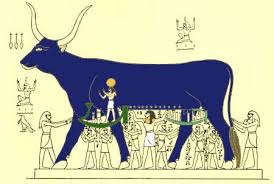
"Hathor is identified with Maat, principle of order, equilibrium, and cosmic harmony..." Question. Any relationship between Hathor and Amun? Besides HORNS of course.
The Egyptians defined that same intent and purpose with the word maat. All explained throughout, from sources that have discussed and written about the same, for countless generations. That first yet final subject, of which the symbol of the 'serpent' archetype, helps with that 'inner' understanding. That 'sting' in the tail...as a precursor to that other major archetypal symbol that represents ‘an intuitive leap’ in relation to an understanding. [ Explained elsewhere ]. Try ''maat'' for a deeper possibly [future?] ''take on things''.
"In the old religion a snake symbolizes the Inner Wisdom that is intuition. Also in 'vision' [ i.e., archetype] it is a symbol for the 'Lord of the moon' [explained elsewhere] sphere. Cernunnos is often shown with serpents as is Hermes, and so are other wisdom gods." ['The New Dimensions Red Book' under the title 'Old Religion'. Mentioned elsewhere]. Recall also those external 'forms' on the South American temple buildings.
Question. What 'number' would represent same principle? Clue - link to the meaning of ''zenith''.
Or within such books as ’On the Mystical Shape of the Godhead ‘. Or 'On the Kabbalah and its Symbolism'. Both by G.Scholem. [ Hebrew equivalent ] Or for a real ‘head scratcher’...’Powers of Imagining’. By I-de- Loyola. Mainly noted...to understand how different authors explain the ‘same’ thing in their own way...and how that same subject has moved forward in ‘leaps and ‘bounds’, because now, not only is that information accessible to all...but more importantly most try to explain it in plain English, or as close to that virtue as one can get, considering the subject matter. That virtue if attained, can only be good for any reader as it is in any subject.
For a more ‘accessible’ read on the same but only when a good understanding has been acquired of several symbols and their meanings. In relation to each other. Try ’The Sufi Path of Knowledge’. By W. Chittick. Compare to...'Mystical Dimensions of Islam'. A. Schimmel OR the author of 'The Tao of Islam' - whom Schimmel recommends.
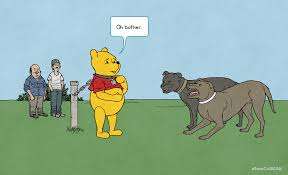
Bear Cub? Understanding that gives a deeper meaning not only to the ''Arthur'' legends but also its relationship to the Great {female} Bear constellation. Question. Which came first and why?

At the pyramid's entrance, an inscription records that Men-Kau-Re died on the 23rd day of the 4th month of the summer. 'Twentythree'?
'Leaps and bounds' = ‘Dog’ symbolism. Sometimes shown by a dog chasing a hare = Unconscious aspect. Think about it, i.e., 'lower' chasing 'higher'...in that as yet 'to be' discovered 'positive' potential, i.e., yet to be 'caught'. Represented with a 'collar' or lead when it is, i.e., 'domesticated', in relation to an 'understanding', i.e.,those 'aspects', now in 'control' of, in the positive sense. An awareness made. Positives over negatives. Representation of.
Working example: Try ''Scorpion King''. Understanding that {added?} information gives caution as to the Egyptian ''legend'' of who united that ancient land.
Jorah Mormont? Lord of Bear Island {Game of Thrones}.
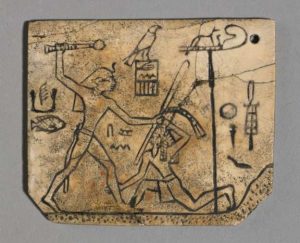
Wepwawet = Lord of the shedshed. AND/OR: In Egyptian mythology, Wepwawet (hieroglyphic wp-w3w.t; also rendered Upuaut, Wep-wawet, Wepawet, Apuat, and Ophois) was originally a jackal deity of funerary rites, war, and royalty, whose cult centre was Asyut in Upper Egypt (Lycopolis in the Greco-Roman period). His name means opener of the ways and he is often depicted as a wolf standing at the prow of a solar-boat. Some interpret that Wepwawet was seen as a scout, going out to clear routes for the army to proceed forward.[1] One inscription from the Sinai states that Wepwawet "opens the way" to king Sekhemkhet's victory.[2] In royal and religious processions, Wepwawet was often depicted on the first standard, opening the way for subsequent standards. He also stands at the prow of the Barque of Ra, usually in human-headed form.
Wepwawet originally was seen as a jackal, or, according to some, a wolf deity, with his cult center being at the Lycopolis, (meaning city of wolves in Greek). He is one of the earliest Egyptian Gods on record. Wepwawet was heavily seen in association with royalty and the Pharaoh (My face is that of Wepwawet, Pyramid Texts), symbolizing and protecting their rise to power, accompanying them on hunts (in which capacity he was titled [one with] sharp arrows more powerful than the gods alone) or in the pharaoh's ascent to the Duat, or afterlife.[3]
Cousin in relation to ''Nephew'' ?
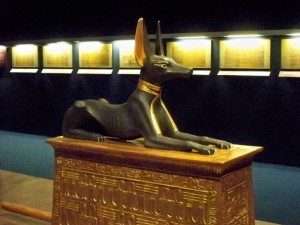
A golden one? ''Pure'' link?
"In Egyptian mythology, Wepwawet is the Opener of the Ways who ushers the dead into the Underworld. He is in the shape of a Jackal but is distinguishable from Anubis; the main conductor of the dead; by his white or grey head, which may suggest he was originally a wolf. He was worshipped as the oldest god at Abydos and at Lykopolis {Wolf City}, which is presently called Assiut." ['The Element Encyclopedia of Magical Creatures' / J. and C. Matthews]. Try ''wolf''.
House Stark? [Game of Thrones].
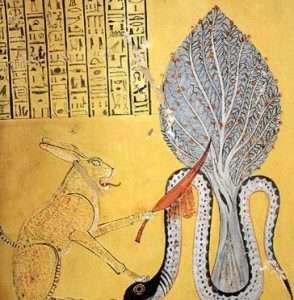
The phrase "cut the head off the snake" is a metaphorical expression that means to eliminate the source of a problem or to remove a leader or key person in order to weaken or destroy an organization or group.
Side note: ''Wroxeter Roman City, once Viroconium, or A. E. Housman's Uricon in his haunting section of a Shropshire Lad devoted to Wenlock Edge, was the legionary fortress of Legio XIV Gemina in AD 60. Paulinus {'fourteenth' legion}, would have been present here - on his way back from Anglesey - to meet up eventually with Boudica....Viroconium Cornoviourum - taken from the French dictionary of Celtic place names translates as 'man-wolf'....'' [Page 191 'Echolands' / D. Mackay].
And/or: ''Dio's Boudica likens the Romans to hares and foxes trying to rule over dogs and wolves.'' [same].
 ''A Shropshire Lad is a collection of sixtythree poems by the English poet Alfred Edward Housman, published in 1896....To an Athlete Dying Young, poem by A.E. Housman, published in the collection A Shropshire Lad. In seven melancholy stanzas, the poet reflects upon a young athlete brought home to be buried, musing that he was lucky to die at the peak of his glory since he will now never experience the fading of that glory.''
''A Shropshire Lad is a collection of sixtythree poems by the English poet Alfred Edward Housman, published in 1896....To an Athlete Dying Young, poem by A.E. Housman, published in the collection A Shropshire Lad. In seven melancholy stanzas, the poet reflects upon a young athlete brought home to be buried, musing that he was lucky to die at the peak of his glory since he will now never experience the fading of that glory.''
Question. Was Housman a member of any 'mystery club'?
Freemason?
Governor / Monarch to enlarge.
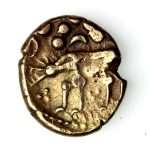
Bird on the rump of a Celtic wolf. "Victory from the jaws of defeat?
''The whites are constantly trying to get somewhere, toward civilization or some city—home. The Housman poem recited at the end of the film speaks of “The happy highways where I went / And cannot come again.” The title and the action are walkabouts.''
N.B. The sixtythree tombs in the Valley of the Kings.
When will the sixtyfour{th} one be found?

64 objective aspects. Good or bad?
''Wenlock Edge is a limestone escarpment near Much Wenlock, Shropshire, England and a site of special scientific interest because of its geology.[1] It is over 19 mi (31 km) long, running southwest to northeast between Craven Arms and Much Wenlock,[1] and is roughly 1,083 feet above sea level. The deciduous woodland which runs along it covers much of the steep slopes of the escarpment and in parts it is very well preserved.''
Offa's Dyke?
What does limestone REPRESENT?

Happy or sad?
Continued: Wepwawet relative to Anubis, i.e., 'wolf' relative to 'domesticated'. Anubis relative to Higher/lower, relative to Horus. Horus relative to Osiris. All relative to A/B/C. All symbolic of something...with the individual in mind.
'Head' of Osiris?
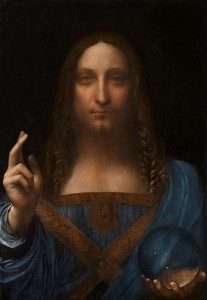 Side note: "The 'menat', a peculiar symbol exclusive to Het-Her, resembles the ancient ceremonial collar. It also corresponds to the Neter's power of expansion...The sceptre of Her-Her was the sistrum rattle..." [Page 99 from the book by R. Clark].
Side note: "The 'menat', a peculiar symbol exclusive to Het-Her, resembles the ancient ceremonial collar. It also corresponds to the Neter's power of expansion...The sceptre of Her-Her was the sistrum rattle..." [Page 99 from the book by R. Clark].
Collar = 'domesticated' i.e., in relation to 'wild' only i.e., knowledge of oneself makes one less ''wild''? To be conscious - to be aware especially of ones 'lower' nature. Helps one to go forward? Check all ''collars'' throughout.
''Stretching the Cord'' ?
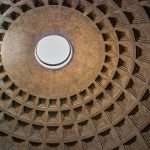
Pantheon to enlarge.
Side note: ''''Bushy Oak, leafy Oak. You tower above all trees....O Hazel, little branching one. Coffer for sweet nuts...O apple tree, true to your kind. You are much SHAKEN by men...'' [Page 444 'The White Goddess' / R. Graves].
'Lightening'?
And/or: ''The sistrum also indicates that the things which exist should be shaken and should never stop moving....For they say that with the sistrum they repel and ward off Typhon, meaning that when decay confines and restricts nature {'fixity'?}, the power of creation sets her free, and restores her by means of movement.''[Page 57 'Hathor Rising'].
Static/Dynamic?

Dawn or Noon? or both?
''However, its main significance for the Egyptians themselves was to control the excessive rage and violence of wrathful deities. By the New Kingdom two types of sistrum were being used after a long process of evolution: the garlanded loop sistrum {includes lotus flower} used by a priestess as an instrument of 'praise' and the 'Gold' naos sistrum. According to an inscription at Dendera, they were played in order to quell divine fury: 'The loop sistrum of the Powerful One, drives away your violence. The naos sistrum of your Ka obliterates your fury.'....''
And/or: ''......The music she plays with the sistrum does not belong to any nocturnal rite of renewal involving the night time goddess 'Gold', who brings the king to dawn {Hathor}...nor to the 'youth' in the eastern horizon {'ihy' link i.e., son of Hathor}. There is a third 'feminine' transformation....an encounter with Amun-Re {at Thebes}....involving the solar father and the king his son {Horus}, brought FACE-TO-FACE at the zenith {'noon'} by a daughter goddess {Isis} - shaking the sistrum between them in an act of mediation.'' [Pages 55-57 'Hathor Rising' / A. Roberts].
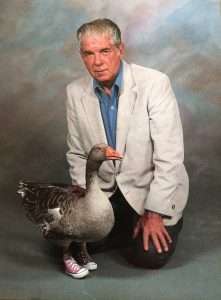 'Pagan' equivalent, i.e., from an ''unknown'' [unconscious?] start point...with an ''aim'' [key] in mind..."She looked out of the window as white as any milk - and he looked in at the window as black as any silk... Hullo, hullo you coal blacksmith, and what is your silly song? You shall never have my maidenhead that i have kept so long!...Then she became a hare, a hare all on the plain, and he became a greyhound dog and chased her back again. And she became a duck, a duck all on the stream, and he became a water dog and fetched her back again. Then she became a fly, a fly all in the air, and he became a spider bold and dragged her to his lair..." [Extract from the folksong 'The Two Magicians' taken from the book 'Where is Saint George'. Mentioned elsewhere].
'Pagan' equivalent, i.e., from an ''unknown'' [unconscious?] start point...with an ''aim'' [key] in mind..."She looked out of the window as white as any milk - and he looked in at the window as black as any silk... Hullo, hullo you coal blacksmith, and what is your silly song? You shall never have my maidenhead that i have kept so long!...Then she became a hare, a hare all on the plain, and he became a greyhound dog and chased her back again. And she became a duck, a duck all on the stream, and he became a water dog and fetched her back again. Then she became a fly, a fly all in the air, and he became a spider bold and dragged her to his lair..." [Extract from the folksong 'The Two Magicians' taken from the book 'Where is Saint George'. Mentioned elsewhere].
Question. "Hare" = earth. "Duck" = water. "Fly" = air. What would 'fire' be represented by; and why. Why bother at all?
Side note: 'Grey' in relation to {as one example} the grey boulders at Elephantine Island AND 'hound' in relation to the Dog Star.
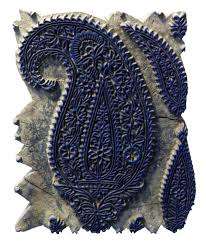
Ahura Mazda = Lord or simply 'spirit' = {eternal 'flame' of Zoroastrian culture}. ''We all know it as paisley''. [Sam Willis 'Silk Road 3/3]. Coincidence or a meaningful one?.
The above a good example of the method used {as one example} in such 'organisations' as the 'mystery clubs'. In order to make each member understand something, i.e.,more often than not in relation to the 'divine bit' relative to that framework - but not all in one go - not all in one lesson. Like any other subject one learns as one goes on, i.e.,as an example different symbols represent different cardinal points,i.e.,east/south/west/north in relation to air/fire/water/earth and/or spring/summer/autumn/winter and/or dawn/noon/dusk/midnight. East -West in relation to 'horizontal'. North to South in relation to 'vertical'. In the middle a candle and/or a rose. All as a representation of something. But because those symbols are universal anyone can understand them, and not just those who wish to partake in the 'ritual' way. There are many methods {or 'flight paths'}. The above 'way' is but one. Try ''method''. The real questions however are the usual ones.
Continued: "Well may you dress your lady fair into your robes of red. Before the morn at this same time I'll gain your maidenhead." [Same folksong]. ''Morn'' in relation to 'dawn' in relation to 'spring' in relation to 'east' = the beginning of something. ''Robes''{initiates?} in relation to 'garment' symbolism. ''Noon'' by the way, would be the next stage; represented with 'fire'. High noon = Zenith {of something}.

''You wouldn't have a match, would you?'' ['Cast Away' / Tom Hanks]. Question. Higher or 'lower'?
That 'fire' that in this subject is related in one form or another to ''spirit''. Intentions of. Purpose of; relative to an understanding - in making something understood- its final meaning ''wrapped'' up in the word - gnosis. Try ''bone'' to see if you agree or disagree.
''Igneous rock is also a rare term used to mean fiery.'' ['The Chase'].
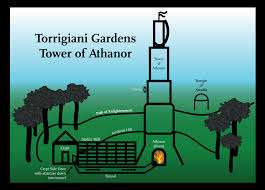
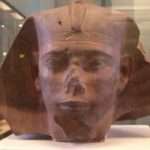
Djedefre.
A working {mindset} example: ''Initiates know that our science, although purely natural and simple, is in no way vulgar; the terms we use, following the masters, are no less so....Thus hoping to enlighten the studious and to divert the blind, the greedy, and the unworthy. Learn, you who already know, that all our purifications, are igneous, that all our purifications are made in fire, by fire, and with fire...These actions described as calcination, because the matter subjected to the flame, yields its impure scorched parts to it....'' [Page 152/385 'The Dwellings of the Philosophers' / Fulcanelli].
Question. How would 'soul' be represented?
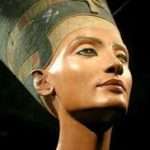

Victory from the JAWS of defeat?
''Alchemy is the art that turns whatever is considered to be ugly, such as a lump of coal, into its highest potential, such as the diamond. What ever is lowly in form, when mixed with 'love' turns divine....In the physical form, suffering creates the friction that heats up the fires of transformation. In the past, we've needed intense experiences such as wars and other sufferings to birth higher levels of consciousness.... A great deal of suffering may become unnecessary as we learn to create from beauty and consciousness rather than from the intensity of suffering.''....There is a certain amount of disintegration that is necessary in order for beauty to burst forth.'' [Page 124 ' Shamanic Mysteries of Egypt' / N. Scully and Linda Wolf].
''Criticism polishes the diamond of truth.'' Wim Hof.
Lotus flower?

 A working example: ''It is ten days after my fathers death. I am in the middle of a seminar, conducting an exercise in which i ask the students to imagine a series of doors that they pass through, gradually taking them to deeper states of consciousness. I decide to join them in the process. I shut my eyes and eventually find myself in front of a very unusual door. The bottom half is paisley, while the upper part is glass. Suddenly, through the glass i see my father grinning at me. I am shocked because my capacity for internal visual imagery is very weak, and yet he appears as clearly as if he was right in front of me with my eyes open. For some reason i say, 'Dad, what shall i call you?' 'Call me popsicle!', he replies and, waves, turns and walks away.'' {a reference to being ''on ice'' at the crematorium much longer than anticipated due a backup of bodies}. [Page 279 'A Mythic Life' / J. Houston].
A working example: ''It is ten days after my fathers death. I am in the middle of a seminar, conducting an exercise in which i ask the students to imagine a series of doors that they pass through, gradually taking them to deeper states of consciousness. I decide to join them in the process. I shut my eyes and eventually find myself in front of a very unusual door. The bottom half is paisley, while the upper part is glass. Suddenly, through the glass i see my father grinning at me. I am shocked because my capacity for internal visual imagery is very weak, and yet he appears as clearly as if he was right in front of me with my eyes open. For some reason i say, 'Dad, what shall i call you?' 'Call me popsicle!', he replies and, waves, turns and walks away.'' {a reference to being ''on ice'' at the crematorium much longer than anticipated due a backup of bodies}. [Page 279 'A Mythic Life' / J. Houston].
Higher/lower - which and why?
A projection of the 'real father' onto the spiritual one? 'Elder' of the animus? - leading the way? In anticipation of the 'flood waters'?
Amun-Ra?
Question. Where would Sekhmet and Athene be placed? {i.e., aspects that the author identifies with}.
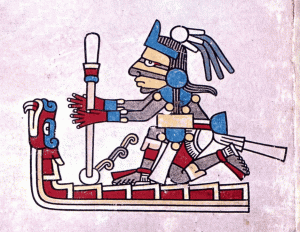 From a different perspective: "The 'Flame' is a reference to the word oodja - a central sign in the Ancient Egyptian benediction: life, vitality and health. The sign signifies ''fire drill'' or an instrument used to start fire or the beginning of a ''burning process''. Used in this manner, the idea that is given is that the Divine Life process {Ankh}, engenders a fire which courses through the body and promotes health." [Page 199 'Egyptian Book of the Dead' / M. Ashby]. Try 2:10 / 5:11.
From a different perspective: "The 'Flame' is a reference to the word oodja - a central sign in the Ancient Egyptian benediction: life, vitality and health. The sign signifies ''fire drill'' or an instrument used to start fire or the beginning of a ''burning process''. Used in this manner, the idea that is given is that the Divine Life process {Ankh}, engenders a fire which courses through the body and promotes health." [Page 199 'Egyptian Book of the Dead' / M. Ashby]. Try 2:10 / 5:11.
'Burning process'' in relation to 'vessel' of the alchemists?
Practical {natural?} example: "Fire is the human signature" [Quote by Prof. Iain Stewart 'How Earth is Made : Fire' Series 1. Episode 4].
'Spirit' or 'soul'?
'Mans Search for Meaning' / Viktor Frankl.
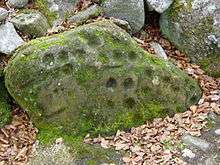
Hard or soft?
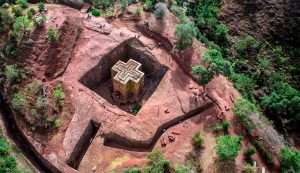
The Church of Saint George was carved downwards from a type of volcanic tuff. This is the sole architectural material that was used in the structure. It has been dated to the late 12th or early 13th century AD, and thought to have been constructed during the reign of King Gebre Mesqel Lalibela, of the late Zagwe dynasty.
Side note: "Seal Stones are made according to the type of stone that they are made from. There are two major types of stone. Hard and soft. The soft stones like soap stone can be 'scratched' with a penknife very easily. The more aristocratic stones needs abrasion - they cannot be carved, and the Mycenaean's had nothing harder than Bronze. Sand has to be used as an abrasion tool. We have depictions of the type of tool used on Roman tomb stones. It comes in the form of a bow - a piece of string/rope attached to two ends of wood. A sharped stick is then used in the middle of the bow string as a type of rotating drill. After many hours etched lines are created {'sculptured/engraved'?} in the stone. Then its polished to a fine smooth surface. Then comes the hard part - drilling a string hole through it." [Professor John Younger: 'Odysseus Returns' / S1 EP1].
Continued: "Simply know that you are going to create fire, that you are creating fire, causing light to shine where there was no light before, bringing warmth, bringing change, bringing all the necessaries of created life's expression. This is a moment of supreme affirmation and confidence. In performing this simple act in a spiritually orientated manner you are bringing profound powers of healing to your own soul. You are expressing the divine principle within your environment..." [Same book, i.e., by G. Knight. Emphasis, this readers].
Question. Nothing more than an invention of the mind; fairy stories?
Side note: "The secret name of Ra was 'Divine fire'...."
'Lifestream' - used throughout in the book by Rosemary Clark.
Lake of the Flame and/or Island of the Flame? Define those two concepts to arrive at a destination. Representing a beginning and end. Neith?
'The Forge and the Crucible' by Eliade.
From a different perspective: {Can u 'see' it?}: ''Historically, there are two separate and apparently unrelated groups to which the name ''Hellfire Club'' was attached. Only the first of these, the one founded by Philip the 6th, Duke of Wharton in 1719, ever called itself by that name.....The club met in the Greyhound tavern near St. James Square {90 degrees?}.....'' [Page 160 'Lords of the Left Hand Path' / S. Flowers].
James the Just?
Sirat Bridge.

Shepherd Kings?

“Most certainly, I tell you, one who doesn’t enter by the door into the sheep fold, but climbs up some other way, is a thief and a robber."
From a different perspective: ''An Apocryphal Gospel said to have been used by the Gnostics in the 2nd century - elaborates of the birth of Jesus in a cave outside Bethlehem: 'And it came to pass...in the time of Herod the King; the wise men came from the East to Jerusalem; according to the prophesy of Zoroaster, and brought with them offerings; namely gold, frankincense, and myrrh, and worshipped him, and offered to him their gifts. Then the Lady Mary took one of his swaddling clothes in which the infant was wrapped, and gave it to them instead of a blessing, which they received from her as a most noble present. On their return the kings and princes came to them inquiring. What they had seen and done? What sort of journey and return they had? What company they had on the road?....It goes on to talk about a feast and/or: ''they made a fire and worshipped it. Cast the swaddling cloth into it. It made NO impression on it.'' [Page 18 'Magi: The Quest for a Secret Tradition' / A. Gilbert].

Spirt-fire in its modern form.
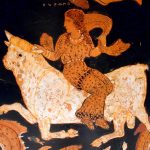 And/or: "By AD 900 a further dimension to the feminine principle was enacted in the institution of Feasts dedicated to the Mother of Mother of God, St, Anne. Although the cult of St Anne did not gain great force until the 15th and early 16th centuries, its seed appeared in the Institution of the Feast of the Conception of St Anne of Byzantium some six hundred years previously. At this time too, tradition has it that the holy Roman Emperor, Charles the Bald, the son of Charlemagne, left in his will the treasured relic of the shift that Mary had worn at the Annunciation. It was to provide a fitting edifice for such a priceless gift that the present beautiful building of the cathedral of Notre Dame at Chartres was constructed in 1194, after the original church had been destroyed by fire, when the relic miraculously survived the conflagration." [From the book by G. Knight].
And/or: "By AD 900 a further dimension to the feminine principle was enacted in the institution of Feasts dedicated to the Mother of Mother of God, St, Anne. Although the cult of St Anne did not gain great force until the 15th and early 16th centuries, its seed appeared in the Institution of the Feast of the Conception of St Anne of Byzantium some six hundred years previously. At this time too, tradition has it that the holy Roman Emperor, Charles the Bald, the son of Charlemagne, left in his will the treasured relic of the shift that Mary had worn at the Annunciation. It was to provide a fitting edifice for such a priceless gift that the present beautiful building of the cathedral of Notre Dame at Chartres was constructed in 1194, after the original church had been destroyed by fire, when the relic miraculously survived the conflagration." [From the book by G. Knight].
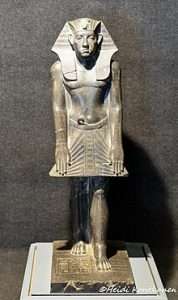
Fire or water?
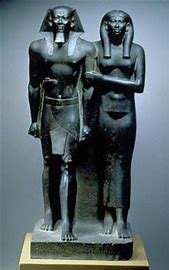
Fire and water. Spirit /Soul. Which and why?
A working {synchronistic?} example: "Over the years i assiduously gathered precious things. So frightened of losing them - i kept them in a fire proof vault {photo's etc}. As i was standing there amongst my treasure - i realised the truth. To this day, i spend most of my life wondering who i was supposed to be. Was i Archie; was i Cary. What was real, what wasn't. Well i introduced them to each other quite recently, and they got along like a 'house on fire'. But the point is it doesn't matter. You could call me whatever you like right now because I know exactly who i am. I'm Barbera Harris's husband, and most of all I'm Jennifer Dyan Grants dad. I belong somewhere and i always will. Everything is copacetic. Look it up in the dictionary. I wish you all the same peace of mind. I think i hear my exit music." ['Archie: The Man Who Became Cary Grant' / 2023].
Hotep.
And/or: What does the famous “my precious” quote mean in The Lord of the Rings? JRR Tolkien’s fantastical epic kicked off one of the best and most beloved movie franchises in existence, but besides giving us Hobbits and Orcs, the Lord of the Rings movies also gifted fans with some timeless quotes.

Senet board game: The 'middle' way.

Hole in the middle. 'Void'?
Every Lord of the Rings fan knows what quote I’m talking about. Let’s not lie; after watching all the Lord of the Rings movies in order, who hasn’t put on a funny voice and said “my precious” at one point in their lives? Gollum (aka one of the saddest and easily one of the best Lord of the Rings characters) made cinema history with his iconic catchphrase, becoming almost the mascot for Peter Jackson’s trilogy.
But did you know that there is more behind Gollum’s words? In fact, his quote has history, meaning and adds a layer of depth to what many already consider the best movies ever made. Well, if you aren’t a Middle-earth expert, don’t worry because below we fully explain the famous, my precious quote for all your adventuring convenience.
Side note: Former Indian ancient coin that was worth a 16th {'sixteen'} of a rupee was called by the 'four' letter word ANNA. The 64th {sixtyfour} of the former monetary unit of Pakistan and India was called a PICE. [internet].
'Unicorn' to enlarge.
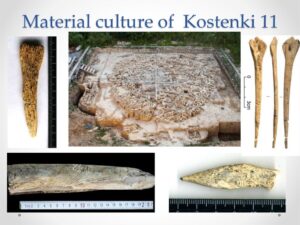
Needles? Any femurs or combs?

From an African slave trader in the West African port of Bonny in the 18th century - from a ship named Anna.
And/or: On the central Russian Plain, a mysterious ring of mammoth bones has been dated to the peak of the last European ice age, when winter temperatures regularly reached -20 degrees Celsius or lower.The site where this ancient structure was found - on the west bank of the Don River, about 500 kilometres (300 miles) south of Moscow - is known as Kostenki 11. The area has a long history of excavation, dating back to the 1700s; early structures were found there during digs in the 1950s and 60s. Thanks to radiocarbon dating, a new study has revealed the discovery of the oldest known bone circle built by modern humans on the Russian Plain; there are about 70 of these mysterious structures littered throughout the area.

Ivory bag rings have been found in more than 70 cemeteries across southern, central, and eastern England dating to between the late-5th and 7th centuries AD. These rings are most frequently found in richly furnished female graves, and would have served as the framework for bags that hung at the waist.... Recent excavations at an early Anglo-Saxon cemetery in Scremby, Lincolnshire revealed a number of elaborate female burials containing such bag rings....Through a multi-methodological approach, we have established that the ivory used for the Scremby bag rings came from elephants living in an area of young volcanic rocks in Africa at some point during the 5th and 6th centuries AD.....Since most rings have been recovered near the hip, it is thought that the bags were suspended from the waist alongside other objects such as iron knives, pairs of copper alloy girdle hangers, and iron ‘latch lifters’ (Vogt, 1960, MacGregor, 1985: 111). 'BOWER' to enlarge.
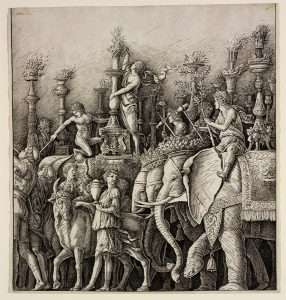
'light oxen': "I bring up an individual type as a point of departure to talk about. The one {'emotion'?} that is strongest will pull you first." [Page 4 'Stopping and Seeing' / Translated by T. Cleary].

Moving 'mountains'?
At the edge of the circle, three large pits were revealed as well, filled with large mammoth bones. Using radiocarbon dating of fragments of charcoal found among the remains, the research team confirmed there was a human presence on the Russian Plain during a time when similar latitudes in Europe were already abandoned. "Yet despite this cold, the widespread distribution of charcoal and burnt bone at Kostenki 11 indicates the availability of wood fuel and the sustained use of mixed-fuel (wood and bone) fires," the authors write in their study.
In fact, this is only the second mammoth-bone circle at which habitual wood burning has been identified. And it's some 5,000 years older than the other one.
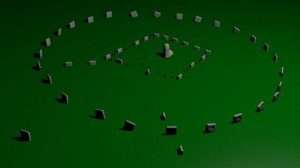
The first 'house' within the first square ever found anywhere. All within Avebury. This islands earliest stone monument. {N/W}
According to CNN, researchers discovered comparable but smaller buildings at this same site in the 1960s and 1970s. The excavation site has since been dubbed Kostenki 11, and it sits 310 miles south of Moscow. This latest find is now officially the oldest and largest “mammoth house” ever found there.
While researchers found evidence of this structure as early as 2014, they only began excavating the following year — and didn’t stop until 2018. Published in the Antiquity journal, their findings detail a structure that measures about 30 feet by 30 feet and is composed of mammoth bones that date back to the Ice Age.
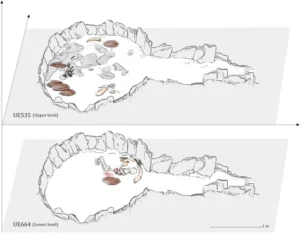
Somewhere else.
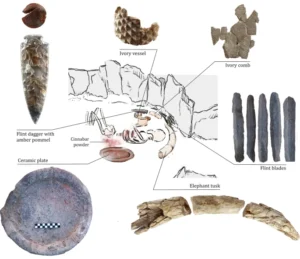
Matriarch / Patriarch.
The discovery adds weight to the idea that conifer trees survived on the Russian mammoth steppe throughout the last glacial cycle. Wood to burn is a prerequisite for many modern hunter-gatherers in high-latitude cold climates, and the availability of trees in this part of the world is a possible reason for why humans persisted here for so much longer than other areas of northern Europe.
Apart from burned wood, the team also identified several plants which could have been used for poisons, medicines, string or fabric, as well as over 50 small, charred seeds. It's still unclear if these were brought by humans or dropped here by randomness, although other remains were clearly manufactured. More than 300 tiny stone and flint chips suggest the people here once used to knap stone tools, likely for butchering animals and scraping hides.
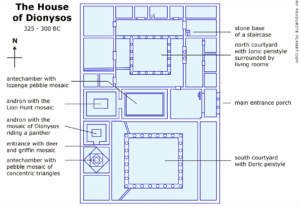

The Elephant House was one of the cafés in Edinburgh where Rowling wrote the first part of Harry Potter.
Side note: "Thus from the moment that Providence determined a principle of social state among men, there was necessarily a principle of property; for the one could not possibly exist without the other. The first instinctive sensations of which the Kingdom of Man may have consciousness are to enjoy and possess for the man and to possess and enjoy for the woman; it is even from this very contrast, as I have shown, that the first emotion which causes all the rest issues.
Property is then a need as inherent in man as pleasure. The sensation of this need transformed into sentiment in the animistic sphere, becoming permanent as all the other sentiments in the absence of the need itself which brought it forth, produces there a multitude of passions whose force is revealed and spread in proportion as civilization makes progress. From the sentiment of property, right is born; from the passions that accompany it are born the means of acquiring this right and preserving it. There is by no means need of an agreement for that; the law which established it is engraved beforehand in the hearts of all." ['Hermetic Interpretation of the Origins of the Social State of Man'].
'Hestia'.
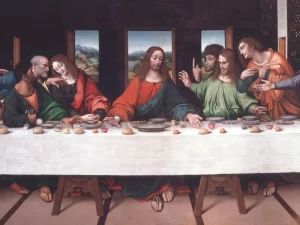
V shape? Window pIllar between. Lake either side?
And/or: The Upper Room has a chapel, which features a nearly life-size woodcarving of Leonardo da Vinci's Last Supper. Services are held in the chapel each Wednesday.[6] Attached to the chapel is the Christian Art Museum, which has a permanent display, reflecting the global ministry of The Upper Room.[7]
The Upper Room has its roots in The United Methodist Church, but its offerings are ecumenical and global. Its vision is "to foster'' an international community of people.....
Finished / UNfinished.
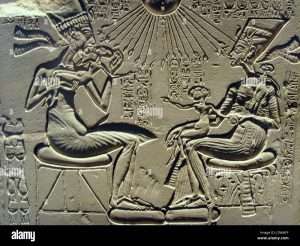
Naked or clothed?
Refresher: ''An Apocryphal Gospel said to have been used by the Gnostics in the 2nd century - elaborates of the birth of Jesus in a cave outside Bethlehem: 'And it came to pass...in the time of Herod the King; the wise men came from the East to Jerusalem; according to the prophesy of Zoroaster, and brought with them offerings; namely gold, frankincense, and myrrh, and worshipped him, and offered to him their gifts. Then the Lady Mary took one of his swaddling clothes in which the infant was wrapped, and gave it to them instead of a blessing, which they received from her as a most noble present. On their return the kings and princes came to them inquiring. What they had seen and done? What sort of journey and return they had? What company they had on the road?....It goes on to talk about a feast and/or: ''they made a fire and worshipped it. Cast the swaddling cloth into it. It made no impression on it.'' [Page 18 'Magi: The Quest for a Secret Tradition' / A. Gilbert].
Spirit or Soul? Primary/ Secondary? Which and why?
AND/OR: Canopic coffin of Tut-ankh-Amun. Each of the four vital organs was mummified, wrapped in strips of cloth and placed in a gold-and-enamel miniature coffin within a cylindrical recess in the canopic chest. This was closed with a human- headed stopper like those shown at left; later, after the Eighteenth Dynasty, three out of each set of four stoppers were given jackal heads. (Page 94 'Egyptian Mysteries' / L. Lamy}.
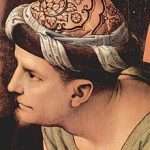
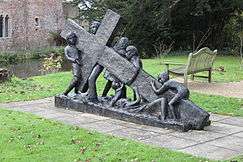
Childs play?
Side note: Swaddling is an ancient practice of wrapping infants in blankets or similar cloths so that movement of the limbs is tightly restricted. Swaddling bands were often used to further restrict the infant. Swaddling fell out of favour in the 17th century. A few authors[who?] are said to be of the opinion that swaddling is becoming popular again, although medical and psychological opinion on the effects of swaddling is largely against. Some modern medical studies indicate that swaddling helps babies fall asleep and to remain asleep and helps to keep the baby in a supine position, which lowers the risk of sudden infant death syndrome
Several authors presume that swaddling was invented in the paleolithic period.[4][5][6] The earliest depictions of swaddled babies are votive offerings and grave goods from Crete and Cyprus, 4000 to 4500 years old. Votive statuettes have been found in the tombs of Ancient Greek and Roman women who died in childbirth, displaying babies in swaddling clothes. In shrines dedicated to Amphiaraus, models representing babies wrapped in swaddling clothes have been excavated. Apparently, these were frequently given as thank-offerings by anxious mothers when their infants had recovered from sickness.
 Amphiaraus was the son of Oicles.[3] This made Amphiaraus a great-grandson of Melampus, himself a legendary seer,[4] and a member of one of the most powerful dynastic families in the Argolid.[5] The mythographer Hyginus says that Amphiaraus's mother was Hypermnestra, the daughter of Thestius.[6] She was the sister of Leda, the queen of Sparta who was the mother of Helen of Troy, Clytemnestra, and the Dioscuri (Castor and Pollux).[7] Hyginus also reports that "some authors" said that Amphiaraus was the son of Apollo.[8]
Amphiaraus was the son of Oicles.[3] This made Amphiaraus a great-grandson of Melampus, himself a legendary seer,[4] and a member of one of the most powerful dynastic families in the Argolid.[5] The mythographer Hyginus says that Amphiaraus's mother was Hypermnestra, the daughter of Thestius.[6] She was the sister of Leda, the queen of Sparta who was the mother of Helen of Troy, Clytemnestra, and the Dioscuri (Castor and Pollux).[7] Hyginus also reports that "some authors" said that Amphiaraus was the son of Apollo.[8]
Continued: From a different perspective: ''Pythagoras attracted murderous rage from those excluded from his inner circle. He refused to admit a man called Cyron into his mystery school., because of his reckless, imperious behaviour. Cyron stirred up a mob against Pythagoras. They broke into the building where Pythagoras and his followers were meeting and set fire to it. Everyone inside died.'' [Page 257 'The Secret History of the World'].
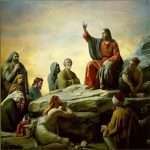
Roof of the 'world'?

Roof or no roof?
And/or: ''The 1st organ of Notra Dame Cathedral was built around 1330 - which included twelve pipes - presently close to 8000 pipes and 5 keyboards...The fire of 2019 destroyed most of the roof...the organ, however, was UNtouched, it also survived the bombings of two world wars....Notra Dame had been built on a sacred Pagan site which honoured the Primordial Mother....The Pagan temples were not allowed to build roof structures over Cosmic sites of power.....Had this something to do with the 'fires' that removed the roof?'' [Page 219 'The Quest of the Rose: The Cosmic Keys of our Future Becoming' / J. Houston + A. Smitsman].
Recall Amarna i.e., ''open aired''.

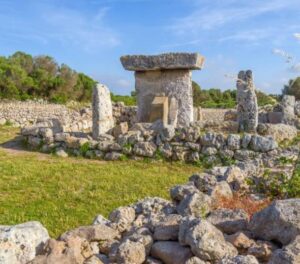
'Truncated' to enlarge.
Stegosaurus (/ˌstɛɡəˈsɔːrəs/;[2] lit. 'roof-lizard') is a genus of herbivorous, four-legged, armored dinosaur from the Late Jurassic, characterized by the distinctive kite-shaped upright plates along their backs and spikes on their tails. Fossils of the genus have been found in the western United States and in Portugal, where they are found in Kimmeridgian- to Tithonian-aged strata, dating to between 155 and 145 million years ago. Of the species that have been classified in the upper Morrison Formation of the western US, only three are universally recognized: S. stenops, S. ungulatus and S. sulcatus. The remains of over 80 individual animals of this genus have been found. Stegosaurus would have lived alongside dinosaurs such as Apatosaurus, Diplodocus, Camarasaurus and Allosaurus, the latter of which may have preyed on it.
They were large, heavily built, herbivorous quadrupeds with rounded backs, short fore limbs, long hind limbs, and tails held high in the air. Due to their distinctive combination of broad, upright plates and tail tipped with spikes, Stegosaurus is one of the most recognizable kinds of dinosaurs.

Water = healing agent?
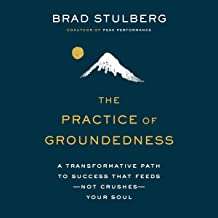 From a different perspective: ''The rift in the metaphysical world has slowly risen into consciousness as a split in the human psyche, and the struggle between light and darkness moves to the battleground within....Approaching the problem from a scientific angle, and innocent of any religious aim, Freud uncovered the abysmal darkness of human nature which a would-be enlightened optimism had striven to conceal. Since then psychotherapy, in one form or another, has persistently explored the extensive area of darkness which i have called the shadow...The figure of Christ the Logos has raised the ANIMA rationalis in man to a level of importance which remains unobjectionable so long as it knows itself to be below and subject to the Lord of 'spirits' {'groundedness'}. Reason, however, has set itself free and proclaimed itself the ruler. It has sat enthroned in Notre Dame as Deesse Raison and heralded events that were to come...
From a different perspective: ''The rift in the metaphysical world has slowly risen into consciousness as a split in the human psyche, and the struggle between light and darkness moves to the battleground within....Approaching the problem from a scientific angle, and innocent of any religious aim, Freud uncovered the abysmal darkness of human nature which a would-be enlightened optimism had striven to conceal. Since then psychotherapy, in one form or another, has persistently explored the extensive area of darkness which i have called the shadow...The figure of Christ the Logos has raised the ANIMA rationalis in man to a level of importance which remains unobjectionable so long as it knows itself to be below and subject to the Lord of 'spirits' {'groundedness'}. Reason, however, has set itself free and proclaimed itself the ruler. It has sat enthroned in Notre Dame as Deesse Raison and heralded events that were to come...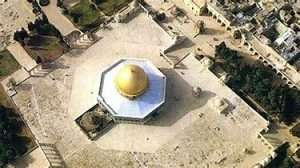

Isle of Wight flag.
To the Christian mentality, the dark antagonist is always the devil. As i have shown, Mercurius escapes this prejudice by only a hair's breadth. But, he escapes it thanks to the fact that he scorn{s} to carry on opposition at all costs. The magic of his name allows him, in spite of his ambiguity and duplicity, to keep outside the split, for as an ancient pagan god he possesses a natural undividedness, which is impervious to logical and moral contradictions. This gives him invulnerability and incorruptibilty, the very qualities we so urgently need to heal the split in ourselves. If one makes a synopsis of all the descriptions and alchemical pictures of Mercurius {i.e.,in one form as the 'Lapis'}, they form a striking parallel to the symbols of the self.'' [Pages 245/6 'Alchemical Studies' / C. G. Jung].
''To be unaware of important information is to be out of the LOOP.'' ['The Chase'].
180* one?
And/or: ''In geometric shapes the Octagon has got one more angle to it than the heptagon.'' ['The Chase'].
''Sixes and sevens''?
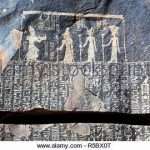
Split roof?
A change of pace..."I am Arnaut, the gatherer of the wind. The one who hunts the hare with Ox. Who swims against the tides turning bind."......."The hare and ox lines are described by Bonner [of Troubadour / South France fame], as probably the most famous three lines in all of Provencal literature." [May-be he should get out more?]. Try ''oxen''.
Arnaut is a Turkish ethnonym used to denote Albanians1. It is also the name of a historical group of people. Arnauts were inhabitants of Albania and neighboring mountainous regions, especially Albanians serving in the Turkish army2. The name Arnaut is also used as a boy's name, meaning "Ruler; Strong As An Eagle.
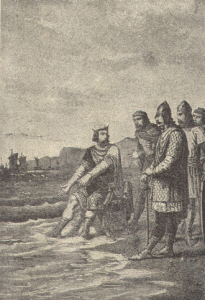
King Canute
.............."In later reference to these lines, it is the ''knowledge'' that becomes his strength. It is because he ''knows'' so much that he can stop the ''incoming tide''.....[Extract taken from the prologue to the book, 'The Zelator' by M. Hedsel].
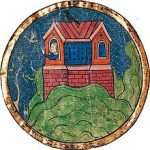 That same link to the answer of Samson's riddle. Found within. Use the search box.
That same link to the answer of Samson's riddle. Found within. Use the search box.
N.B. Mediterranean = non tidal. Enlarged elsewhere, i.e., cold - warm as a means...?
"''For a while i lay passive, feeling depleted and tired beyond words. Then gradually there arose a tide {key} within myself - a tide of life revitalized every part of me." [From the book by A. Duncan].
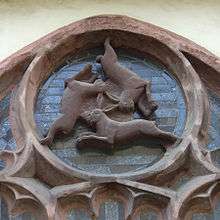 Additional information to seek a 'connection'?... "Hera is ingeniously identified with the Moon when Homer uses favourite epithets to describe her throughout the epic. During the course of Book 1, she is first said to be 'white armed' and then 'Ox eyed', before becoming again 'white armed' - rather meaningless phrases unless they are considered astronomically. Similar instances occurring throughout the Iliad, describe a monthly lunar cycle, from the waxing crescent of the new moon {'white armed'} to the full moon {'Ox eyed'} and then on to the waning crescent {'white armed'} of the old moon...During the seduction scene in Book 14, Hera's usual aggressive mood {''mad mood''?} changes. Homer uses sublime language to describe her 'captivation' of Zeus, which is in astronomical terms a fine portrayal of a lunar eclipse..." ['Homer's Secret Iliad']. Try ''eclipse''.
Additional information to seek a 'connection'?... "Hera is ingeniously identified with the Moon when Homer uses favourite epithets to describe her throughout the epic. During the course of Book 1, she is first said to be 'white armed' and then 'Ox eyed', before becoming again 'white armed' - rather meaningless phrases unless they are considered astronomically. Similar instances occurring throughout the Iliad, describe a monthly lunar cycle, from the waxing crescent of the new moon {'white armed'} to the full moon {'Ox eyed'} and then on to the waning crescent {'white armed'} of the old moon...During the seduction scene in Book 14, Hera's usual aggressive mood {''mad mood''?} changes. Homer uses sublime language to describe her 'captivation' of Zeus, which is in astronomical terms a fine portrayal of a lunar eclipse..." ['Homer's Secret Iliad']. Try ''eclipse''.
Question. Nothing more than the attempt to define an eclipse or is the eclipse used to define something else...as a means...?
''Ox eyed'' - like a hare caught in the headlights? {of a 'car' ?}. Try ''oxen'' for a further connection.
Question 2. How would a Solar eclipse be represented.
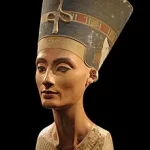
Half a story?
''The way of 'marriage' seems fraught with....all consuming passions. More often than not, the hungry inner self has been eclipsed by the outer personality....Within these eclipsed areas - where our needs, wants and beliefs remain secret, even to ourselves - lies ones shadow....Two halfs never created a whole but only another half so long as the shadow remains eclipsed.'' [Pages 84/85/104 'Dreams of Isis: A Womans Spiritual Sojourn' / N. Ellis].
And/or: ''However, we all know that white light must have its twin or balancer in shadow. This is the menstrual rhythm of the black goddesses - the new moon. The value of this rhythm in the cosmic sense is Necessity - pathologizing and wounding in psyche and substance. Here is the raw, open and unpredictable Dionysian current, the Romantic in culture. In alchemical lore this is the black of the dark moon and eclipsed moon {hidden or concealed light of the sun}. The hidden masculine rises on the outer feminine as recognition by the woman of the inner husband, other lover, inner-child or Red King: the animus....Here is the inspiration of death {daath?} as a teacher, but not of morbidity, for the potential 'child' that is as yet unborn - is reborn in an INNER-SENSE {in innocence}, as a deepening to fresh values.....'' [Page 254 'Fruits of the Moon Tree' / A. Bleakley].

Solar or lunar? Right hand? 'Positive or negative' impression?
Side note: "The Fourth Branch is as rich a field as the Mabinogion hunter could wish for, in which the young sun-god suffers a small eclipse only to rise brighter on the morrow {dawn?} and perform more splendid deeds of 'valour'." [Page 89 'Mabon and the Mysteries of Britain' / C. Mathews]. ''zero?''
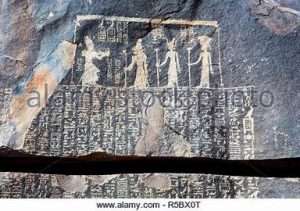
Famine Stela. Beginning or end of something?
''It is often believed that times of breakdown are needed for times of breakthrough to emerge.'' [Epilogue to the book 'The Quest of Rose: The Cosmic Keys of our Future Becoming' / J. Houston + A. Smitsman].
''Wounded'' to enlarge in the Micro SENSE of the word and ''catastrophe'' in the Macro sense i.e., end date/times of cultures.
A practical example: ''Sometimes you have to lose to win.'' Roy Keane {player/manager}.
Continued... "With Hera dressed in her finery, she works her magic on Zeus, and the moment of seduction describes a total lunar eclipse. While Homer draws this image of a total lunar eclipse, he does not attempt to describe the astronomical reasons for it. This suggests that he was unaware that a lunar eclipse occurs when the moon passes through the earths shadow. Homer draws attention to the physical appearance of the moon in the guise of Hera when on several occasions he associates it with human feelings and a popular, even childlike, image of its face..." [Same book].
Question. Did Homer not understand? Or is he attempting to give the reader something else to ponder on {digest?}.
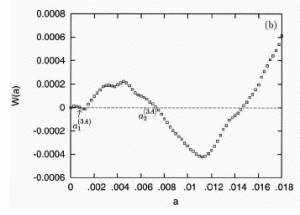
 Something hinted at: "So, my friend, we are back to words {food for thought?}. The things we so utterly believe in, and trip up over so easily. Yet, what we all overlook is that words are really understood only in silence: to understand {'see'?}, you must push back the sound of the voice, and listen to the silence behind the sound, tuning in to the soul who speaks. This is not mystical nonsense - this is realism; if you listen to the sound, there can be no understanding. The meaning lies behind the sound. Perhaps this is the secret of the zero. In any case the eclipse is complete, and is answering your question about the zero. We are looking down the earth's shadow into what appears to be nothing {'void'?}: yet it is really the dancing ground of angels." ['The Zelator']. Try ''eclipse'' and/or ''angel'' as well as the highlights - in their universal context - not just the obvious one.
Something hinted at: "So, my friend, we are back to words {food for thought?}. The things we so utterly believe in, and trip up over so easily. Yet, what we all overlook is that words are really understood only in silence: to understand {'see'?}, you must push back the sound of the voice, and listen to the silence behind the sound, tuning in to the soul who speaks. This is not mystical nonsense - this is realism; if you listen to the sound, there can be no understanding. The meaning lies behind the sound. Perhaps this is the secret of the zero. In any case the eclipse is complete, and is answering your question about the zero. We are looking down the earth's shadow into what appears to be nothing {'void'?}: yet it is really the dancing ground of angels." ['The Zelator']. Try ''eclipse'' and/or ''angel'' as well as the highlights - in their universal context - not just the obvious one.
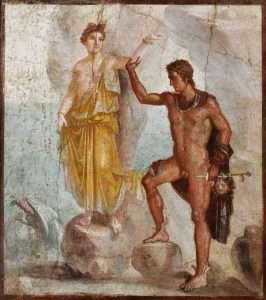
'HERO'?
Seen/UNseen. Recall the shadow SEEN between the Sphinx and the right shoulder of Khafre's pyramid. Underworld? Return journey?
How would that ''return'' be represented within a landscape?
A proven: ''I decided to test Joe Campbell hypothesis that myths are corporeal or at least contained innately in the memories of sinews and the caches of the brain....I would have to look for them in their PUREST form in the minds of children - and not just any children, but ones who had not been exposed to radio, television, or movies, from which they could have picked up mythic stories....I was looking for the causal zone of myth. After a search i was able to locate a number of children whose parents refused to have any media in the house.'' [Page 95 'A Mythic Life' / J. Houston].
The author goes on to describe a ''new story'' as requested of a young man called Jimmy who searches within himself for one. Briefly; VERY briefly: ''Once upon a time there was a little boy, who had a mummy; loved his mummy, married her; had many babies; and then goes away with his sister.'' The author believing the above relates to the Oedipus myth. For this reader it relates more to the Egyptian culture - Pharaohs, mothers and sisters. Meritaten in particular. Enlarged elsewhere. A more PROVEN example - for this reader - with possible synchronistic links would be:

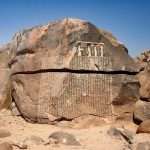 ''I think this is the hardest thing I've ever done. But i will tell you without shame, that i pray i come out of here a better man, and a thankful man, for all my blessings....I've been told countless times I'm too much to hang around with - the reason i don't have many friends....I've been thinking of all the people I've neglected along the way....Especially mother and father....Life's a tragedy all around for all of us, but now I'm sat here in Rock House with all this time on my hands, at the apex of my career, it gives time for thought - {reflection} 'i feel i haven't done my family right especially parents and sister....I've pursued everything that I wanted to do without considering them - but in the end it can only be what it is - 'it is what it is' - I like that saying....Todays day ninetynine; Christmas Day. I plant this Christmas tree with this star i made on top at Rock House. I'II never forget this Christmas. Never as long as i live....I never thought that anything could change me or crack me, but I'm certainly going to be a more thankful man....{Day after} ''Today is day 100. This is a great
''I think this is the hardest thing I've ever done. But i will tell you without shame, that i pray i come out of here a better man, and a thankful man, for all my blessings....I've been told countless times I'm too much to hang around with - the reason i don't have many friends....I've been thinking of all the people I've neglected along the way....Especially mother and father....Life's a tragedy all around for all of us, but now I'm sat here in Rock House with all this time on my hands, at the apex of my career, it gives time for thought - {reflection} 'i feel i haven't done my family right especially parents and sister....I've pursued everything that I wanted to do without considering them - but in the end it can only be what it is - 'it is what it is' - I like that saying....Todays day ninetynine; Christmas Day. I plant this Christmas tree with this star i made on top at Rock House. I'II never forget this Christmas. Never as long as i live....I never thought that anything could change me or crack me, but I'm certainly going to be a more thankful man....{Day after} ''Today is day 100. This is a great 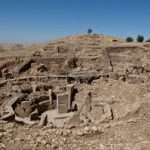 day for me. Very
day for me. Very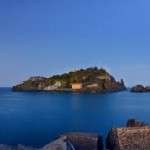 great. Just struck off day one hundred on this calendar tree. Day one - all the way down there at the base ....I dedicate this day to my deceased mother....{reflection} ''I've always been alone. Even when I'm with someone or in a crowd - a sort of island that way.... Its dead silent right now, dead silent and calm. Everything has a rhythm and a beat and a silence....i just love to hear that dead silence - if that makes any sense." [Roland / winner of 'Alone' / History Channel/ 2020].
great. Just struck off day one hundred on this calendar tree. Day one - all the way down there at the base ....I dedicate this day to my deceased mother....{reflection} ''I've always been alone. Even when I'm with someone or in a crowd - a sort of island that way.... Its dead silent right now, dead silent and calm. Everything has a rhythm and a beat and a silence....i just love to hear that dead silence - if that makes any sense." [Roland / winner of 'Alone' / History Channel/ 2020].
Refresher: "Everyone has an internal thought process: that silent other self who speaks to you; the one you debate with." [First sentence; first paragraph; first page of the book by Q. S. Lam].
'She Who Loves Silence'?
REFRESHER: ''The star of your being is rising.''
''Westward leading still proceeding, guide us to thy......?
''Manger'' to enlarge.
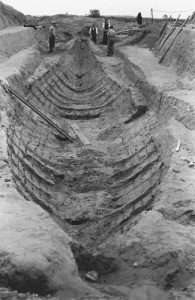
'Eightyeight' feet in length: REFRESHER: ''Good deeds are ships on which to ride the waves.''
Side note: ''The old St. Pauls Cathedral dated from the 11th century. Took '153' years to complete...Became one of the largest buildings in Europe.''......And/or: ''It took 'thirtyfive' years for Christopher Wren to rebuild - after the 1666 fire...'Star' shaped pattern in the 'middle' of the transept {'right angle' link}....It has 'eightyeight' spiral steps in the S/W Tower leading up to the Clock Tower.'' ['Mirthy' /July 2022].
Greenwich Mean Time?
Saturn?
And/or: ''Michelangelo died at the age of 88.'' ['The Chase'].
 ''Greenwich - one of the Royal Boroughs in London is home to the historic Royal Artillery Barracks.'' ['Impossible' / S8 EP28].
''Greenwich - one of the Royal Boroughs in London is home to the historic Royal Artillery Barracks.'' ['Impossible' / S8 EP28].
Side step: "Good evening. I'm Dr Emmett Brown. I'm standing in the parking lot here at Twin Pines Mall. It's Saturday morning October 26th {'twentysix'} 1985 1.18am. This is temporal experiment number one....If my calculations are correct, when this baby hits 88 mph your going to see some serious shit." ['Back to the Future' / 1985].
P.S. From 'twentyfive' years back into the 'future' - a clock tower has to be struck by lightening in order to return to source {"10.04pm on a Saturday night"}.
'Queendom' to enlarge.
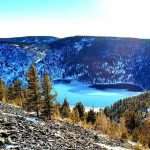 Continued: Something extra: "Qabalists attribute ''Hearing'' to Vau. This links up with the Hindu philosophy, because hearing is the sensation produced by sound vibrations, and sound vibration is what Hindu's call 'Akasha ', the primal substance of which all things are made. It is the same as the Quintessence of the alchemists. Akasha is described as the ''mixing bowl'' of the elements, or as an ocean {salt or fresh?} of substance in which the other 'elements' are like waves...." [Page 146 'Occult Fundamentals and Spiritual Unfoldment' / P. Case].
Continued: Something extra: "Qabalists attribute ''Hearing'' to Vau. This links up with the Hindu philosophy, because hearing is the sensation produced by sound vibrations, and sound vibration is what Hindu's call 'Akasha ', the primal substance of which all things are made. It is the same as the Quintessence of the alchemists. Akasha is described as the ''mixing bowl'' of the elements, or as an ocean {salt or fresh?} of substance in which the other 'elements' are like waves...." [Page 146 'Occult Fundamentals and Spiritual Unfoldment' / P. Case].
Eurynome?
And/or: "A blue whale's sound repertoire includes pulses, buzzes, and rasps. Their sounds are likely used for communication and navigation. They have very loud voices - their sounds can be over 188 decibels (louder than a jet engine) and at 15-40 Hz, are usually below our hearing range. Like humpback whales, male blue whales sing songs....
As light becomes increasingly irrelevant underwater, sound becomes more important than ever. It’s unsurprising that cetaceans - dolphins and whales - rely on sound more than any other sense to understand, navigate and manipulate their world. While apes are renowned for their colour vision, and humans like to think of themselves as visual creatures, cetaceans have no use for expensive ocular equipment. Instead, they have evolved some of the most distinct, complex and unique acoustic anatomy and behaviour on earth. Cetaceans see and feel with sound."
Blue stars are the hottest. Red the least hot.
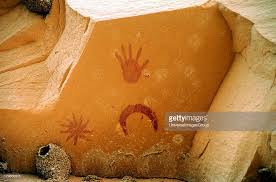
The beginning of something {''Eclipse''?}. AS a means...? ''Crack''?
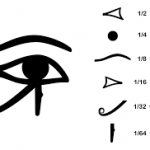
Eye of the storm.
A working example: "Heart or reason, no matter! They are ruled by the stars. My instincts, my nature, my body...all is determined by number, by the stars, forces whose plaything i am. Why give us the illusion that our heart is master? My heart is a puppet, a slave, like all else, of fate. The sage waited for the storm of primordial grief to abate. Then he lifted his grave voice and Her-Bak seated himself, trembling. 'My son, there is error in what you have just said. Your heart, seat of enlightenment, {sia}...is it not here that your divine Ka dwells? But your Ka isn't fate's slave, for it is no part of nature. All else on Earth or in Heaven, even the solar disc that lights us, is part of nature, but the spirit-soul like the divine Ra, is not. If the spark {exploding star or helical rising?} becomes conscious in your humanity it grows into a vital germ and through this, if you let it govern the animal-human in you, you will be master of your fate. The soul is not subject to the stars.

Horizontal/vertical. Something 'inner' being 'warmed' from something outer. . {Static/Dynamic}. Finally sheds its skin. Evolving into something new - in the spiritual sense of the word. Spirit/soul as a means....?
Side note: "....the focus of spiritual initiation and evolution were related as an ''unveiling of Isis''....The reference to being ''conceived'' through the goddess is a clear relation to ''divine birth'' i.e., to be ''born again''....It is also a reference to the Serpent Power {'kundalini'?}. Isis and sister are the goddess of the serpent power {El-qurn?}. Being 'born' of them means being born of elevated consciousness....which is the innate life force {cold/warm?}, latent in every human being." [Page 191 'Egyptian Book of the Dead' / M. Ashby].
Question. Why a snake. Many wonder why. Authors like David Icke make a living on it. 'Spiral' form in shape. Close to the ground - almost hugging the earth as if in an embrace. Sheds skin. Can 'rise' in the vertical to strike like 'lightening'. As above so below as a means....?
Forked Tongue? {as opposed to say a 'dragon'}.
Continued: 'But all my being suffers their influences!'
''As you have just suffered the depressing experience of an eclipse, {'zero'?} for the instinctive self is subject to them {ais}. But as soon as animal man begins to obey his higher self he only feels them as inclinations, no longer compulsions..." ['Her-Bak'].
And/or: {sia} = total understanding including that ''bit''. {ais} = without it i.e., in the Gnostic {'seeing'} sense of the word.
'See' it?

'M'?
And/or: ''The faculty of reasoning....the comparing of any two notions {'duality'}. 'Crossing' is what symbolizes this idea....The intermeshing of threads forms a woven fabric, wherefore Neith {Net} is called the neter of weaving. It is noteworthy that the hieroglyph for a notion allied to science, knowledge, a savant or comprehension depicts a piece of woven material, and is read sia.'' [Page 156 'Sacred Science' / R. A. schwaller de Lubicz i.e., above authors husband].
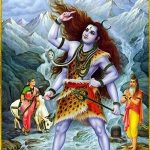
Manifested or UNmanifested?
As one example: ''A hymn to Atum-Ra: I am the great Neter who has made himself, who creates his names, the master of the divine Ennead. What means this? It is Ra creating the names of his limbs, meaning the neter's that are in his following came into existence. The solar barque's procession through the hours confirms what was said concerning Sia, and thereby reveals a meaning of the boat: manning the double helm is Sia, knowledge, along with Hu, usually translated as taste, a meaning that equates to senses.
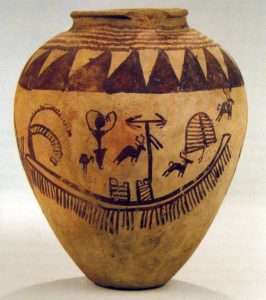
When the north wind blows. Heading south?
This symbol of the solar barque can be summarized as follows: Ra's energy, at this specific hour, must be perceived so that the vital teaching at this hour be put into practice.'' [Page 162 'Sacred Science'].
The Greek Zoe/Bios?
Followers of Horus?
Side note: Understanding that connection {i.e., husband/wife} - together with remaining family members and friends - solves the riddle of 'Fulcanelli'.
Something to ponder on: "The ancient Egyptians measured the stars along the ecliptic as they gradually changed in position over the ages, and not in tropical {stationary} terms as practised by most modern astrologers. However, if in ''the beginning of time'' Sirius rose heliacally at the summer solstice as Egyptian legend relates, then a tropical arrangement of the dekans should begin with Sirius at zero degrees Cancer...The zero month of Djehutet is the intercalary month of variable length...The Roman historian Censorinus reported that the heliacal rising of Sirius occurred simultaneously with the beginning of the solar year - the first of Djehut." [Pages 114,133/5 of the book by R. Clark].

Strong or weak eye?
And/or: The author J. Sellers defines the Corona of same natural effect as the ''Diamond Ring'' that she hypothesises the Egyptians used in relation to Precession. Many references to the ''eye'' made throughout. But only in its historical context in relation to Precession.
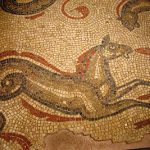 And/or: ''As has been said, Ra is not the sun itself, but rather the solar energy {'spirit'?} which, during the course of its daily cycle, animates all the organic {'soul'?} functions of the human body, one after the other, at each hour of the day and night. It is in this way that we are subject to it....Each month is subdivided into 'THREE' periods of ten days called decans. Each decan is subject to the influence of one particular neter. Knowledge concerning these influences goes back to at least the ancient empire... as seen in the Pyramid Texts....The secret refers to knowledge in the plant world....an example is given in the six paragraphs in the Treatise of the Eyes...specific remedies for strengthening the vision: 'What must be done from the 1st winter month to the second winter month. Another remedy would be efficacious from the 3rd to the 4th winter month {'three and four'?}, and still another......
And/or: ''As has been said, Ra is not the sun itself, but rather the solar energy {'spirit'?} which, during the course of its daily cycle, animates all the organic {'soul'?} functions of the human body, one after the other, at each hour of the day and night. It is in this way that we are subject to it....Each month is subdivided into 'THREE' periods of ten days called decans. Each decan is subject to the influence of one particular neter. Knowledge concerning these influences goes back to at least the ancient empire... as seen in the Pyramid Texts....The secret refers to knowledge in the plant world....an example is given in the six paragraphs in the Treatise of the Eyes...specific remedies for strengthening the vision: 'What must be done from the 1st winter month to the second winter month. Another remedy would be efficacious from the 3rd to the 4th winter month {'three and four'?}, and still another......
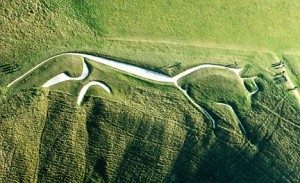
Puissance?
.....can be taken all year round - throughout the three seasons'....The decans are endowed with a great divine virtue and with a peculiar puissance: everything happens by their degree. All things fortunate and unfortunate.'' [Pages 157/8 'Sacred Science' / R. A. de Lubicz].
When all the available information is assessed what do you think?
'Knock three times'?
Refresher: "The children of Seth [Set] first possessed that peculiar sort of wisdom, which is concerned with the heavenly bodies",[chapter five.' The Sirius Mystery'].
As {one} example: ''Intriguing, in Thebes, is the development of the Ogdoad which multiplies to the extent of becoming fifteen. The fact must not be overlooked that the number 15 is no longer in relation with the primordial principles but with the monthly and lunar character of Tehuti {Thoth} i.e., Saturn as Lead. Thebes represents the ultimate phase of the first royal becoming....At Karnac its birth'' [Page 196. Same book].
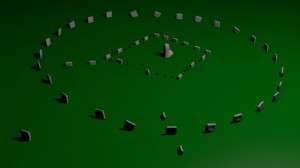
'Square' and 'circle' connected by 'triangle' ? Recall the first three letters of PYRamid. Enlarged elsewhere? A 'house' {temple?} found just behind the central pillar. Question. Real or symbolic? ['Digging for Britain'. Series 6. Episode 1]. Try ''three and four''.
 "Consider this 'zero' of yours carefully. It is almost a circle, a symbol of spirit. We are trained, by our own mental inertia, to think of the zero as a circle containing nothing. But a circle is also a shape which circumscribes everything. When you draw nothing, in the form of a zero, then by default you draw everything outside of it. There are secrets here that can scarcely be put into words. Why did the Indian gurus express the Etheric, their akashya, as a circle? Why did the Hebrew esotericists insist that the open letter 'aleph' was to be accorded the enclosed zero?. And so, if everything is a symbol, so is this circle we sit in - this place and time. It can be no accident {synchronistic?} that we sit in a place when an eclipse is taking place...Here, in this eclipse, my own mind perceives a meaning which is different from the one you perceive, yet however we define it, an eclipse is a meeting of circles which are zeros. See how the shadow of the earths rim cuts the Moon down to a crescent. Soon the crescent will be gone...The Moon will appear to be a dark zero - a nothing. Then the cycle will begin again, breathing new life of light into the Moon...A great zero of light in the skies...Could this be the reason why the Fool of the Tarot pack is given the strange {'peculiar'?} number zero? ['The Zelator'].
"Consider this 'zero' of yours carefully. It is almost a circle, a symbol of spirit. We are trained, by our own mental inertia, to think of the zero as a circle containing nothing. But a circle is also a shape which circumscribes everything. When you draw nothing, in the form of a zero, then by default you draw everything outside of it. There are secrets here that can scarcely be put into words. Why did the Indian gurus express the Etheric, their akashya, as a circle? Why did the Hebrew esotericists insist that the open letter 'aleph' was to be accorded the enclosed zero?. And so, if everything is a symbol, so is this circle we sit in - this place and time. It can be no accident {synchronistic?} that we sit in a place when an eclipse is taking place...Here, in this eclipse, my own mind perceives a meaning which is different from the one you perceive, yet however we define it, an eclipse is a meeting of circles which are zeros. See how the shadow of the earths rim cuts the Moon down to a crescent. Soon the crescent will be gone...The Moon will appear to be a dark zero - a nothing. Then the cycle will begin again, breathing new life of light into the Moon...A great zero of light in the skies...Could this be the reason why the Fool of the Tarot pack is given the strange {'peculiar'?} number zero? ['The Zelator'].
Try ''peculiar'' as strange as it may seem - if only to those 'first impressions'.
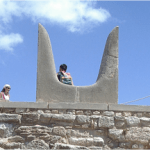
''V'' ?
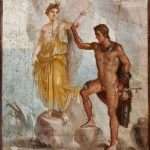
Hero?
''Called by astronomers the First Point of Aries, this junction where the sun crosses the equator in its northward journey marks zero point in the measurement of right ascension which can be conceptualized as celestial longitude.'' [Page 117 'The Orion Zone' / G. A. David].
Side note: "The fact that the 'Aleph' of the Hebrew alphabet is linked with the constellation Taurus, at a time when this was the first asterism of the zodiacal constellations, has been taken by some to mean 'First Born', to whom the letter was sacred." ['Page 90. 'The Secret Zodiac'].
And/or: ''House'' in relation to: "Satellitium is a group of three or more planets lying in one 'house' of the zodiac''. ['Wiki']. Try ''house'' in the {Micro} sense of the word. Then ''Saturn'' in the {Macro} sense of the word - for possible answers - other than the norm.
Refresher: "The Kingdom of Heaven is within you. The time has come for external forms and expressions to be left behind. There is no 'Temple' in the heavenly Jerusalem, for religion has no place in Heaven. Man is his own Temple. A mans heart is the altar of god...."

Try ''chick'' / ''hen'' as a means....?
A side step: "The Mahabharata, one of the great sanskrit epics of India, tells of how Brahma emerged from a Lotus that sprang from the navel of Vishnu, seen in terms of the sacred lake at Pushkar. Other accounts speak of him as the first conscious mind of the universe, existing within the 'golden nucleus' [Hiranyagarbha], which germinated after being 'sparked off' by a mysteries 'First Cause'. On awakening, Brahma took his first breath, at which the physical universe came into being. The entire act of 'creation' is said to have proceeded from Shabda-brahman, the 'sonic absolute,' conveyed by the process of Naada-brahman, the 'primordial sound or vibration of Brahma'. this is thought to fill the entire expanse of the universe and becomes audible to yogins, or ascetics, when they achieve higher states of consciousness. It is symbolically expressed in terms of the conch shell, perhaps reflecting the age old belief that shells contain the 'sound' of the primordial ocean. [Chapter 16, 'The Cygnus Mystery'. Mentioned elsewhere].
Understanding this subject by way of certain 'keys'[highlighted]. Regardless even when a different 'language' is used , gives clues as to the origins / start point of that 'religion'. Especially...
''The swan is white without spot." Enlarged elsewhere.
Side note: {A working example?}: ''Without blemish'' - a title given to women by Amenhotep the third.

Question. Waiting for a call from Donald 'duck' or Miss 'swan'? All to fly South?
 "Versions of Brahma's birth found in early Sanskrit writings, including the religious texts known as the Puranas, speak of him gestating in a golden egg [the Brahmanda], 'laid' by Hamsa, through which he came to be known as Kalahamsa [or Kalahansa], the swan- goose of eternity, or swan goose in space and time. Others talk about how Brahma came to earth either on the back of the swan - goose, or on a chariot, drawn by seven swans. Indeed, he is said to have been in his swan chariot when the lotus dropped from his hand, creating three water sources, one of which being Pushkar's sacred song.
"Versions of Brahma's birth found in early Sanskrit writings, including the religious texts known as the Puranas, speak of him gestating in a golden egg [the Brahmanda], 'laid' by Hamsa, through which he came to be known as Kalahamsa [or Kalahansa], the swan- goose of eternity, or swan goose in space and time. Others talk about how Brahma came to earth either on the back of the swan - goose, or on a chariot, drawn by seven swans. Indeed, he is said to have been in his swan chariot when the lotus dropped from his hand, creating three water sources, one of which being Pushkar's sacred song.
"Brahma; from Sanskrit root 'brih' - to expand. When Emerson's poem ''Brahma'' appeared in 1857, most of the readers were bewildered, Emerson chuckled. ''Tell them,'' he said, ''to say 'Jehovah' instead of 'Brahma' and they will not feel any perplexity." [Extract from the book 'Autobiography of a Yogi'. Mentioned elsewhere].

Sacha Dench - the Human Swan.
"In Greek mythology the swan was the bird consecrated by Apollo; a symbol of harmony...'' [and or ''equilibrium''. This readers input]. Wikipedia / swan song.
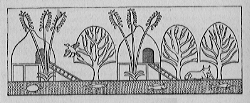
'Reed' huts? Pavilion?
The silver swan, who living had no note, when 'death' approached , unlocked her silent throat. Leaning her breast against the reedy {papyrus?} shore, thus sang her first and last, and sang no more. 'Farewell, all joys! O death come close mine eyes! More geese than swans now live; more Fools than Wise."
Analogy?..."Hector is tricked by the goddess Athene and is left unarmed to face Achilles, who dispatches him, with a lance thrust to his throat." ['Homer's Secret Iliad'/ Mentioned elsewhere].
Side note. Throat chakra? One of five or seven or does it matter?
''The six swans is a fairy tale told by the Brothers Grimm.''
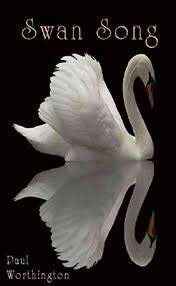

Fire or water? Grimm or joy?
"Swan Song = final performance or activity; in Greek legend; final effort; gesture just before 'death' or retirement."..."The term derives from the legend that, while the swan is mute during its life; swans sing beautifully and mournfully just before they die. The legend was known to be false as early as in the days of ancient Rome, when Pliny the Elder refuted it in 'Natural History' AD77. Nevertheless; poetic imaging proved to be more attractive than scientific method..." [Wikipedia and www.phrases.org.uk]. Death/rebirth link? i.e.,the tail end of something begins...
Side note: ''In the UK, any unmarked mute swan belongs to the Queen.'' ['Lightening' / BBC2].
''The Queen Elizabeth 2nd Bridge at Dartford links the ends of the M25 {'twentyfive'}.''
''A smaller version of the Statue of Liberty stands on Swan Island in Paris, France...in the fifteen{th} arrondissement.''
''Little'' to enlarge.
Side note: 25th letter of alphabet = 'Y'.
And/or: ''The two largest Channel Islands have names ending in 'y'...'' ['Tipping Point'].
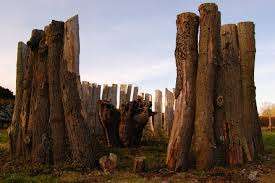
Seahenge. 'Y'?
''Scholars variously surmise that Jersey and Jèrri derive from jǫrð (Old Norse for 'earth') or jarl ('earl'), or perhaps the Norse personal name Geirr (thus Geirrsey, 'Geirr's Island').[32] The ending -ey denotes an island[33][34] (as in Guernsey or Surtsey).''
''The island's name, "Guernsey", like that of neighbouring "Jersey", is of Old Norse origin. The second element of each word, "-ey", is the Old Norse for "island",[7] while the original root, "guern(s)", is of uncertain origin and meaning, possibly deriving from either a personal name such as Grani or Warinn, or from gron, meaning pine tree.[8]
Previous names for the Channel Islands vary over history, but include the Lenur islands,[9] and Sarnia; Sarnia is the Latin name for Guernsey, or Lisia (Guernsey) and Angia (Jersey).''
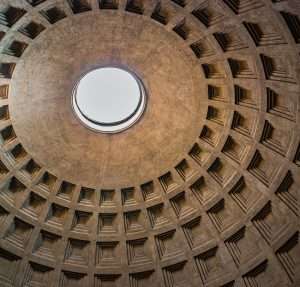
Oculus of the Pantheon = ''Bulls eye''.
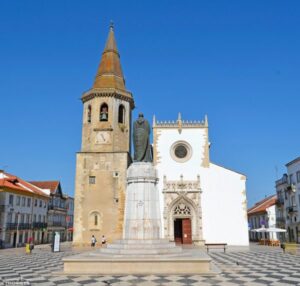
The Church of Saint John the Baptist (Portuguese: Igreja de São João Baptista) is a 15th-century Catholic church in Tomar, Portugal that was built by King Manuel I and is of Manueline architecture. As its name implies, the church is dedicated to Saint John the Baptist.[1] It has been classified as a National Monument since 1910.[2] AND/OR: How can I describe my first communion on Mount Athos? I first began to draw conclusions some hours later that day. I was sitting beside the big pine tree overlooking the jetty, trying to sort out the many and fastchanging impressions of my visit. | would alternate between periods of questioning and periods repeating the Jesus Prayer. The stillness of the water reflected the stillness within. Somewhere across the little cove a muleteer shouted at his charges as they began their journey into the forested center of Athos. Birds sang. The novices practiced their chanting in the music school that occupied the top floor of the nearby old building, outside the monastery walls, a rickety-balconied building built against the cliff, and which also housed the carpenter’ shop. Bees shopped lackadaisically at the broom on the cliff below me. A fishing boat moved slowly across the horizon. Behind all these sounds lay the stillness of Athos... an inward stillness. Within that stillness emerged a presence I can never describe. I was not then even sure how to put a name to the presence. I am still not sure. {'A Different Christianity' / R. Amis}.
continued...C, Bb, G, Eb, C = E. N. W. S. E. This is the counter pattern to the above, and useful for closing down...[Extract from the book 'Rose Cross and the Goddess'].
All as a representation of something as is wind/UNwind or rolled/UNrolled papyrus - enlarged elsewhere. So to is...
'Who Is in My Temple' AND 'In The Temple of Silence' ['Cosmic Chants' by Paramahansa Yogananda].
Question. Where along that Nile river do the Temples re-orientate themselves? Question 2. Why?

Seahenge. Trunks split down the middle.
"... The mystic understood Gandhi's insistence, ''God is in the rock, too - in the rock!" The poet appreciated Eckhart's paradox, ''Split a stick of wood, and the Christ is in there, too." [Extract from the book 'The Cosmic Trigger']. Recall the difference between ''mystical'' and ''magical'', i.e.,top/down - bottom/up?
"Light of the World" (Greek: φώς τοῦ κόσμου Phṓs tou kósmou) is a phrase used by Jesus to describe himself and his disciples in the New Testament.[1] The phrase is recorded in the Gospels of Matthew (5:14–16) and John (8:12). It is closely related to the parables of salt and light and lamp under a bushel, which also appear in Jesus' Sermon on the Mount.
{Wood}-henge relative to {Stone}-henge? North/south? Represented within landscape symbolism and/or mythology, i.e.,King Arthur legend? Try ''bear''.
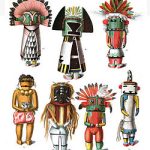
Akashic record witness and or Watchers?
Side note: "According to Pindar, the "pure light of high summer" (hagnon phengos oporas) is Dionysian, or perhaps it is even Dionysos himself....A vase painter of the fifth century wrote next to the childlike figure of the god emerging from the thigh of Zeus: Dios phos, "light of Zeus." This light was originally the light of Sirius and the gift promised by the verdant vineyards, a gift of the ambivalent star.....

Light of the mind?
The Naxians saw and celebrated Ariadne in two forms. According to their historians, a gloomy festival was devoted to a mortal Ariadne and a joyful one to another whom Dionysos took for his wife. The god himself was also celebrated in two forms on Naxos. In one form he was called "Dionysos Meilichios," and his mask was carved of fig wood. In the other he was the ecstatic "Bakcheus," and his mask was carved from the wood of the vine. In Dionysos Meilichios (the same epithet was applied to the subterranean Zeus, who appears on Athenian votive reliefs in the form of an enormous snake) we may recognize the ancient seducer of the cave marriages; in Bakcheus, the young bridegroom of island marriages. The name "Bakcheus" is connected with the image of the Dionysian thiasos, the ecstatic band of bacchantes and agitated male nature gods in a state of heightened zoe which is not reflected in Minoan art. The description of the arrival of the bridegroom with such a retinue was reserved for later art and poetry. From the earliest times on, however, the core of the rite, the "higher marriage," had been associated with Naxos as well as Crete." {'Dionysos: Archetypal Image of Indestructible Life' / C. Kerenyi}.
Continued: ''Split-twig figurines {''V''?} as well as pictographs such as those found in the Shamans Gallery {i.e., V-Bar-V-Ranch} indicate the cultural importance of this part of the Grand Canyon {especially the north RIM}. The Grand Canyon considered by the Hopi to be the great Sipapuni, the Place of Emergence {into the light?}, the origin of a people who ascended from the subterranean plane called the Third World where they had previously lived {'involutionary'?}, and currently the place to which the spirits of the dead return and the katsinam live....The Bow and Bear clans were the first to arrive at Hopiland....'' [Page 168/9 'The Orion Zone' / G. A. David].
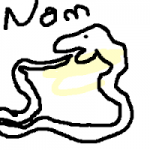
As part of that ''true poetry''. Others found throughout.
Continued: From a different perspective: ''My thesis is that the language of poetic myth anciently current in the Mediterranean and Northern Europe was a' magical' language bound up with popular religious ceremonies in honour of the moon goddess, or muse, some of them dating from the Old Stone Age, and that this remains the language of TRUE poetry....but it is only fair to warn the reader that this remains a very difficult book, as well as a very queer one {'peculiar'?}, to be avoided by anyone with a distracted, tired or rigidly scientific mind...." [Forward to the book 'The White Goddess' / R. Graves].
Side note: Why a 'serpent'? Crawls on belly {horizontal?} but can strike in the vertical? Can be found in both salt and fresh water? Sheds its skin? etc. All as a means...?
Try ''poison/antidote''.
Refresher: "The children of Seth [Set] first possessed that peculiar sort of wisdom, which is concerned with the heavenly bodies",[chapter five.' The Sirius Mystery'].
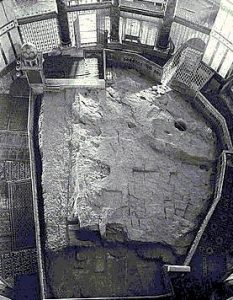
Another 'aspect' of that ''true poetry''. A hole in a foundation stone in the S/E corner.Hole in the head? Back of it = 'cave' link?

''Rock of ages, cleft for me, let me hide myself in thee.''
"A monk who had meditated long in search of Illumination finally received a great flash of insight. Rushing to his 'roshi' {Zen Master}, the monk cried out, 'I have it! I have it! That rock there is inside my head.' "You must have a big head," the Master replied, ''to hold a rock that size." [Extract from the book 'The Cosmic Trigger'. Mentioned elsewhere].
Something 'Set in Stone' ?
Side note: ''Saxifraga is the largest genus in the family Saxifragaceae, containing about 465 species of holarctic perennial plants, known as saxifrages[2] or rockfoils.[3] The Latin word saxifraga means literally "stone-breaker", from Latin saxum ("rock" or "stone") + frangere ("to break"). It is usually thought to indicate a medicinal use for treatment of urinary calculi (known as kidney or bladder stones), rather than breaking rocks apart.''
Help section to enlarge.
And/or: ''The adjective word 'renal' refers to two organs in the human body {kidneys}.'' ['The Chase'].
''Dual lobed''?
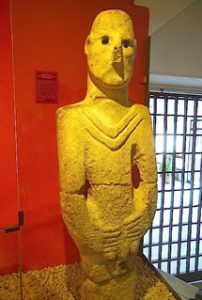
'Chevron'?
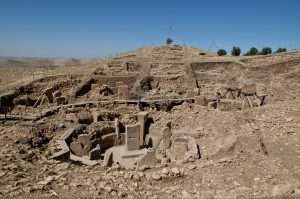
Primordial hill?
From a different perspective: Atum surges out of the cosmic waters in the form of the primordial hill. He then ‘spits out’ (ishish) the first of the divine qualities or powers: Shu, the Principle of air and of space, symbolized by the feather he wears on his head. Atum then ‘expectorates’ (tint) the second Principle, the lion-headed Tefnut, who most probably represents the element of Fire. In another version, ‘Atum gives birth to himself through masturbation at Heliopolis’, causing ‘the seed from the kidneys to come’ (Pyramid Texts, 1248). He then brings the twins Shu and Tefnut into the world. In a third version, Atum creates himself by the projection of his own heart, and brings forth eight elementary principles which, together with himself, make up the Nine, the Great Ennead of Heliopolis: Shu and Tefnut, then Geb, the Earth, Nut, the Sky, and finally Osiris and Isis, Seth and Nepthys, entities of cyclic life and renewal, of death and rebirth.
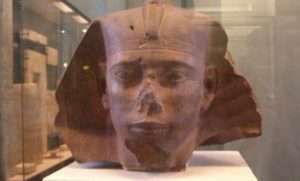
"He is the king who introduced the royal title Sa-Rê (meaning “Son of Ra”) and the first to connect his cartouche name with the sun god Ra." Generation or resurrection?
Side note: A similar text further says, that when, before the Creation, Atum the Demiurge wished that his heart might live, Nun said to Atum: Breathe in thy daughter Maat, bring her to thy nose in order that thy heart may live. That she be not removed from thee, that thy daughter Maat be with thy son Shu whose name is Life. Thus even before the Creation the awakening of Consciousness (Maât) provokes the first breath (Shu) issuing from the nostrils of the Creator. It is Shu who sustains life, causes the heart to beat and the lungs to breathe, and who, in one myth, brings forth the initial egg at the origin of time.
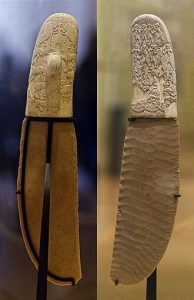
Gebel_el-Arak.
CONTINUED: It is written that ‘none of these entities is separate from him, Atum’ (Pyramid Texts, 1655). Thus by means of self-coagulation, or by his semen, or by the projection of his heart, Atum creates. The evocative images of the Pyramid Texts are further elucidated by a ‘Coffin Text’ from the Middle Kingdom (after 2040 Bc) in which the dead person, who identifies himself with each of the divinities he evokes, says: ‘I was the soul of Shu who is on the flame, the fire that Atum produced from his hand when he masturbated.’ The male seed is here considered a catalyst, or in alchemical terms a ‘styptic fire’: a coagulating agent which causes the ‘first earth’ or ‘primordial hill’ to emerge from the undefined cosmic substance of the Nun. This initial condensing agent is symbolized by the spermatozoon which coagulates the female albuminous liquid exactly as the heat of a flame does the white of an egg.
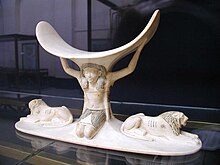
Tutankhamun's head rest. 'Raised' by Shu.
In addition, the mention of the ‘soul’ of Shu indicates that we are still in the realm of subtle elements, thus of abstraction. Atum of Heliopolis is thus seen as the carrier of the invisible fire or seed the cause — still metaphysical — of the first definition to arise from the undefined Nun. He then brings forth from himself the group of nine divine principles eight of them plus himself) which will order the Becoming — the Great Ennead. In the Pyramid Texts this Great Ennead doubles, and then itself becomes a generative power.
'Duality'.
‘The King came forth from between the thighs of the divine Nine’, or again ‘from between the thighs of the two divine Nines’, relating the number nine to generation. The ancient Egyptians intuited a great deal from their understanding of the natural laws of numbers....
It has been discovered only recently, with the aid of the electron microscope, that the spermatozoon is formed of a head and a long tail made up of nine threads....
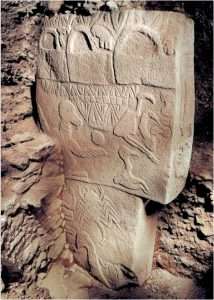
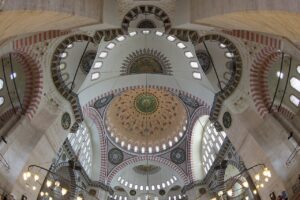
Ostrich eggs among the lower lights in the mosque of Suleiman.
It is carrier of a centriole composed of nine (or multiples of nine) tubes, and these tubes direct the entire process of the division of the living cell, a division which is in fact a multiplication.
It is the action of the sperm that causes the female ovum to contract immediately after penetration and to form an englobing membrane, thereby prohibiting the access of any other sperm. The centrosome then divides and the centrioles are carried to the two poles of the ovum. There is contact between the two pronuclei, male and female: an impalpable instant, immediately followed by the division of the cell into two new cells, which will also in turn divide. This process of halving is at the basis of all Pharaonic mathematics, as is confirmed by the famous lines, l am One that transforms into Two, l am Two that transforms into Four, i am Four that transforms into Eight. After this i am One. (Coffin of Petamon, Cairo Museum no. 1160.) {'Egyptian Mysteries' / L. Lamy}.
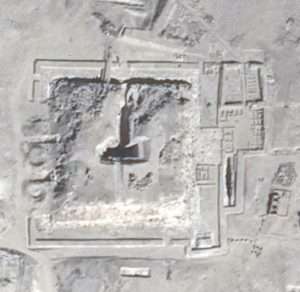
Oblong hole? Shadow?
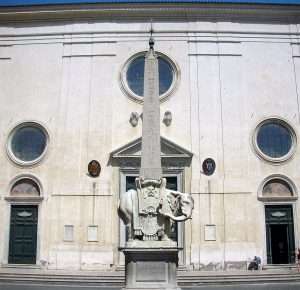
The Philosophers Stone? 4 sided = 4 'elements'?
Analogy of same, [in relation to an understanding] but from a different start point..."Mithras bore the title ''rock born'' and ''god from the rock.'' The rock of Mithras birth contained both light and fire, he who is born from the rock is thus a 'fiery' god of light. This conception is almost certainly based on a very ancient tradition dating from the time when man first discovered that both light and fire could be produced by striking flint." Quote from the book by D. Fideler. Recall the symbolic intent of ''stones'' and ''flint.''
''Fire is the human signature''. Try ''signature''. As a {'natural'} means...?
''In the Christian tradition, the twentyfifth of March - is the date that Mary was told she would give birth to Jesus.''
Tomb/Womb.
''Conception'' to enlarge.

Charioteer?
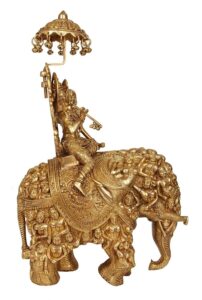
Side note: Something to ponder on: "The hermeticist who is aware of the indwelling divine spark and the attempt which must be made to kindle it and take the evolutionary journey into the heart of the macrocosm, has only to consider the implications of Christs incarnation - an involutionary journey into the heart of the microcosm in order to bring Divine Fire to the indwelling spark. The universal application of this action is not dependent upon production of a baptismal certificate, but applies to all. The story of the divine spark is our story too, as we have already seen. It is the skilful use of this story - whether one uses the Christian model or another - which brings us out of the Vale of Tears into the inner kingdom: not that one should give up, neglect or forget one's inner life for a moment, but one must learn to work in it, with it and out of it {'forest'?} so that the unity of one's soul may break out into one's activities and one's activities shall lead one back to that unity...'' [Page 270/1 'The Western Way'. Vol 2. C + J Matthews].
Try ''Mr Smith'' or Miss Jones'' to take a further step.
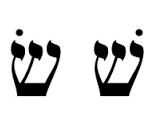
Hebrew 'Shin' = Teeth?
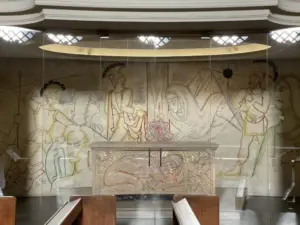
But the most famous artworks associated with Notre Dame de France are the paintings by Jean Cocteau, his only murals outside France. Decorating the walls of the Lady Chapel, Cocteau worked on the paintings between 3-11 November in 1959.
Continued: "I am immeasurably grateful for the humbling blows he dealt my vanity. I sometimes felt that, metaphorically, he was discovering and uprooting every deceased tooth in my jaw {'bolt'?}. The hard core of egotism is difficult to dislodge except rudely. With its departure, the 'divine' finds at last an unobstructed channel. In vain 'it' seeks to percolate through flinty hearts of selfishness." [Extract from the book 'Autobiography of a Yogi']. Try ''teeth'' and ''bolt'' to attempt a MIND SET.
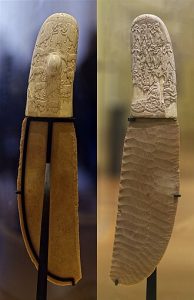 Ascending 'passage' in Gt. Pyramid? As a means....?
Ascending 'passage' in Gt. Pyramid? As a means....?
PRONE.
Flip side?... "Therefore, it is said of Christ by the prophet Ezechiel that his face is like a diamond because it is so attractive and a flint that with a little blow of meditation sparks a fire of love in the heart that is disciplined and prepared to receive it." [From the book 'The Third Spiritual Alphabet' by Francisco de Osuna].
''Criticism polishes the diamond of truth.'' Wim Hof.
'Hercules'?

"Victory from the JAWS of defeat."

"Shrink away from fear and it becomes your master. Beating your chest, gnashing your teeth, and howling at the injustice of it all only exacerbates your plight."
"The appropriateness of creating fire by friction on actual wood should be born in mind. Although a flame might with efficiency be produced with a gas lighter it is not immediately 'fitting'. In all of this, it is not meticulous rules that we seek to provide, but a developed sense of symbolic appropriateness. We seek efficient function that is a clear expression of a spiritual intention within consciousness." [Extract from the book by G. Knight]. Try ''wood''.
The difference being one represents the beginning of something the other closer to 'its' end. Animate /inanimate. Alchemy equivalent: 'Plant' in relation to 'mineral' symbolism. Movement in relation to non-movement - as a representation of something. Question. Which is what?
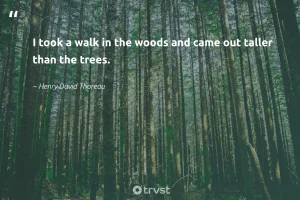

Teeth for a 'key'?
Side note: A 'tooth' and 'liver' found in a SQUARE wooden box with Hatshepsuts name - found within the Valley of the Kings among Fifty Royal bodies. The tooth fits one of the bodies found elsewhere {KV60} along side the one thought to be the ''wet nurse'' of same. Conclusion - ''more than likely to be Hatshepsut''. [Egypt's Unexplained Files / History Channel].
'Gnashing of teeth' = Spirit or soul related?
Among others {highlighted} 'fifty' to enlarge.
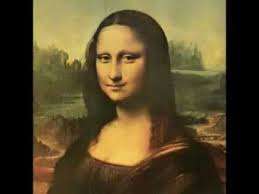
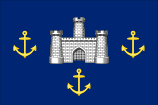
Council flag.
And/or: "...as the search for, and manifestation of truth - she has to show 'herself' to all in the full light of equality - the veil, half drawn back, should reveal the secret individuality of a 'second' figure, artfully concealed under the form and attributes of the first. This second figure is philosophy. In Roman antiquity the 'veil' was used to dress Minerva, daughter of Jupiter, AND the only goddess whose birth was 'miraculous' {''pure'' link?} - ''sprung fully armed from the head of her father'' whose 'head' had been 'split' by Vulcan {'fire'?}. Greek name Athena the root of which links to 'wet nurse', mother - meaning born without a mother - personification of the wisdom or knowledge of things - the divine and creative thought, materialised in all nature, latent in ourselves as it is in everything that surrounds us," [Pages 447/8 'The Dwellings of the Philosophers' / Fulcanelli].
Anima or animus? as a means....?
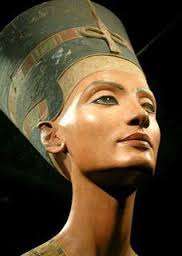
Flat top or round top?
''Imponderable, elusive, always in motion {dynamic/static?] - fire possess all the qualities we acknowledge in spirits; fire is nevertheless material as we see its light when it shines and, even when it is dark - we can detect its radiating heat. Is not the spiritual quality of fire revealed by its flame? Why does the flame always rise as a true spirit, in spite of our efforts to force it down? Is this not a formal manifestation of which, by liberating it from material hold, moves away from the earth and brings it nearer to its celestial native land? What is the flame if not the fires true visible form, signature and effigy?...A pure physical manifestation of purity itself - it signifies in this sense of the word its spiritual origin and uncovers its 'divine' affiliation." [Page 421 same book].
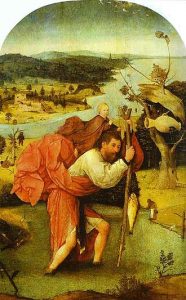
''...in the story of St. Christopher who carried the Christ child on his 'shoulders' - In the Cabala these two 'dimensions of meaning' are contained in the three pronged letter shin.'' [Page 292 'The Secret History of the World']. Dome shape as opposed to say 'tower' shape.
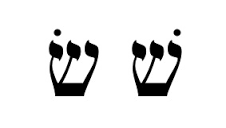
To 'grind' and digest the 'food' of the material world or the food of the 'gods' ? AS a means....? Side note. A three pronged symbol found on the cliff side at Paracus. Northern peninsula. Can only be seen from the sea. The origin of the Nazca people.
Exercise. Put all the above together to define..." This famous Jewish myth relates the story of Moses leading his people out of captivity in Egypt by miraculously parting the Red {'reed'?} Sea. There follows '40' years of wandering in the wilderness in search of the Promised Land, at the end of which Moses dies. It is his successor, Joshua ben Nun, who miraculously parts the river Jordon to lead the Jews to the destined homeland {''three and four'' See it?}. The name 'Jesus' itself comes from Exodus. In Greek the Hebrew name 'Joshua' becomes 'Jesus'. Today it is normal practice to use Joshua for the hero of Exodus and 'Jesus' for the hero of the gospels, which avoids any comparison of the two. At the time, however, it would have been completely obvious that they shared the same name. This is not a coincidence. The Christian Jesus is a mythic development of the Jesus of Exodus. In Hebrew the name Joshua/Jesus is written with the letters Yod/Heh/ Shin/ Vah/ Heh. The letters Yod, Heh, Vah and Heh, known as the Tetragrammaton, {enlarged elsewhere} were extremely significant to Jewish gnostics, as they were used to signify the unpronounceable name of god, usually rendered today with added vowels as either Jehovah or Yahweh. As Philo explains, when the middle letter 'Shin', known as the 'Holy' letter is added, the name means 'Saviour of the Lord'. [From the book by T. Freke and P. Gandy].
'New Name' ?
The eight Heh of Egypt?
Moses in relation to 'sea'. Joshua in relation to 'river'. Others highlighted {in one form or another} - to define something other than the obvious - i.e.,''unpronounceable'' in relation to 'silence' - benefit of.
"Pagan and Christian gnostics imagined the initiatory journey to be about awakening the 'King' within. In Pagan Mysteries, the initiate was 'enthroned' as a king as part of the initiation ceremonies." [Same book]. Try ''throne''.
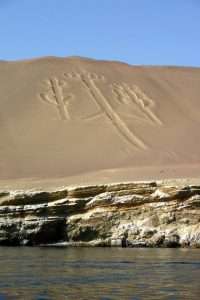
In the local ''harbour''? Question. A stylized 'M' OR 'W'? Cassiopeia?
Refresher: A three pronged symbol found on the cliff side 'by the sea' - locally named the ''candelabra'' - the most ancient of the Nazca geoglyphs - Their beginning. The start of something.

''Duc in Altum, built in 2014 to commemorate the PUBLIC life of Jesus and the dignity of women. The main ALTAR abstractly replicates a 1st century fishing boat in the ancient harbour.'' Question. Wind in the sails?
Side note: ''After the 'miracle' of the multiplication of the SEVEN loaves of bread, Jesus gets into a boat and comes to the region of Magdala named Dalmanoutha. The name and place are disputed, being either Magdala or an area north of same...Magdala = Migdal meaning 'tower'....'' [Page 30-32 'Mary Magdalene: Insights of Ancient Magdala'].
Leavened/UNleavened?
That link to the individual.The beginner/student or apprentice. No more so symbolized than in mythology. Especially Greek mythology. As explained in Robert Graves. ‘Greek Myths.’ Or Walter Burkert's 'Greek Religion.' The inner struggles of the ‘apprentice/beginner’ symbolized no more so than within those Greek ‘Hero-s’. All symbolic of those different ‘aspects’ of an individuals inner nature. Higher/Lower self.
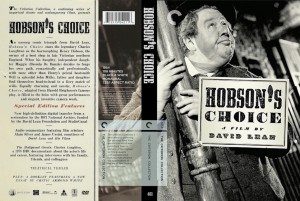

Amongst the most recognisable silks and colours were those of Her Majesty Queen Elizabeth, which combined purple, scarlet and gold braiding. Horses owned by JP McManus are also instantly recognisable to racegoers and spectators at home thanks to their bold combination of green with gold hoops.
The Ricci family, meanwhile, have their jockeys wear baby pink silks with bright green spots, while the silks worn by jockeys riding the Thoroughbreds of Prince Khalid Abdullah are equally famous with their green and white combination embellished with a pink sash.
"When Perseus grows to maturity, the King of the Underworld throws a banquet. In accordance with ancient custom the status of those invited is assured by the fact that each has to give a horse {refresh in Part 1} - to the host. Perseus is unable to meet this test of status but announces that he will enable himself to qualify presenting Polydyktes with the head of Medusa. In ancient times she was considered to have the body of a horse, and indeed was originally a mare, who 'mated' with Poseidon himself in the form of a stallion. Perseus undertakes this quest as a means of bringing release for his mother {Apron - strings?}. In this we see a crisis point at the stage in the evolution of consciousness. It is the point where dependence upon the mother has to give way to assertion of independence.

'Silk' ?
This occurs in the process of growing to maturity in all human individuals, and has its equivalent in the puberty of the human race. This is the dynamic behind many of the hero legends. The hero is the one who is compelled to assert himself, to prove his individual worth by the performance of certain tests, or a quest. This is particular relevant in the case of Perseus, for it will be seen, that achievement
Side note: ''In the terminology of certain Eastern teachings the first body is the 'carriage' {body}, the second body is the 'horse' {feelings, desires}, the third body the 'driver' {mind}, and the fourth the 'master' {I, consciousness, will}, sometimes referred to as the 'divine' body.'' [Pages 859-921 {Kindle} 'In Search of the Miraculous'].
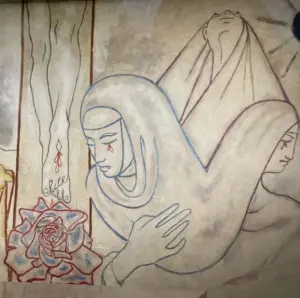
The Church of Notra Dame de France - Soho - London. Aries-Pisces?
'Diamond' body?
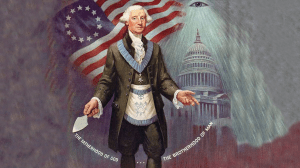
'Apron'? A 'builder' of that inner stuff?
Continued: .....of this state of psychic independence will also be a release for the mother. On the other hand, failure to win free of the maternal influence, or mother's aura, will produce that petrification of the will that is so graphically described in the imaginary of the Medusa's look that can turn her victims to stone. She is the terrible possessive mother, in this aspect. The spider woman who sucks the souls of her victims and renders them dry desiccated shells {'carapace'?}. These victims are her own children. In later legend Perseus was helped by the god Hermes who lends him winged shoes so that he can leave the island upon which he is confined. This island being an image of the physical world as defined by the outer senses; and the winged shoes confer the ability of walking the 'sky-ways' of inner reality..." [Extract from the book by G. Knight].

'Three and four'?
Question. Is this subject therefore nothing more than an overplay {over-emphasis?} on the psychic interpretation of mythology? OR even vise-versa.
Question 2. "...petrification of the will." - Woodhenge in relation to Stonehenge - but now in the positive sense? Representational of: {cedars?}.
A working example: "Among Edna's papers are many pages of notes which reflect her intensive research into myth and the families and ancestry of great heroes in support of her hypothesis. Eventually she had constructed a basic catalogue of stars and constellations from the 'Catalogue of Ships'..." ['Homer's Secret Iliad']. Enlarged throughout.
In geology, petrifaction or petrification (from Ancient Greek πέτρα (pétra) 'rock, stone') is the process by which organic material becomes a fossil through the replacement of the original material and the filling of the original pore spaces with minerals. Petrified wood typifies this process, but all organisms, from bacteria to vertebrates, can become petrified (although harder, more durable matter such as bone, beaks, and shells survive the process better than softer remains such as muscle tissue, feathers, or skin).....
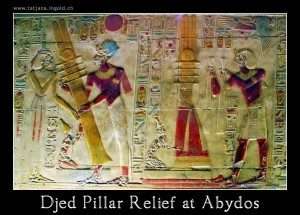
''Raising''?
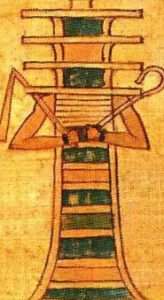 Petrification takes place through a combination of two similar processes: permineralization and replacement. These processes create replicas of the original specimen that are similar down to the microscopic level.[1]
Petrification takes place through a combination of two similar processes: permineralization and replacement. These processes create replicas of the original specimen that are similar down to the microscopic level.[1]
"For it to be called a fossil - it has to be at least 10000 years old."
A fossil (from Classical Latin fossilis, lit. 'obtained by digging')
Side note: In the Golden Legends Mary Magdalene is said to have wiped the feet of Christ with her 'tears'. Then wiped his feet with her 'hair', before anointing with 'oil'. Later on it is said that she retired to a cave in the mountains of Provence, France, where each morning she is raised by 'seven' angels to the top of the cliff before being returned to the cave.

Do they always stay ahead of Orion? What about in the Southern Hemisphere?
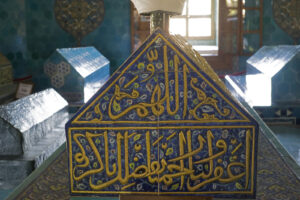
The Green Tomb (Turkish: Yeşil Türbe) is a mausoleum of the fifth Ottoman Sultan, Mehmed I, in Bursa, Turkey. It was built by Mehmed's son and successor Murad II following the death of the sovereign in 1421. The architect Hacı Ivaz Pasha designed the tomb and the Yeşil Mosque opposite to it.[1]
In addition to the sultan's sarcophagus, it contains seven other tombs: those of his sons Mustafa, Mahmud and Yusuf, his daughters Selçuk, Ayşe and Sitti and his wet nurse (Daye Hatun). Set amid cypresses on top of the hill in the Yeşil neighborhood in Bursa, the mausoleum stands higher than the rest of the complex. It is built on a hexagonal plan and crowned with a hemi-spherical dome. The exterior of the mausoleum is clad with the green-blue tiles that give it its name.
The Seven Keys of Heaven of the Bristol variant, or ‘seven was the Gate of Heaven’ is usual terminology for the Seven Lower Spheres upon the Tree of Life, also represented as Seven Gates to be negotiated in one’s attempt to reach immortality. These are shown as the Druidic realms of the Other-world, which the heroes of the ‘Spoils of Annwm’ had to pass through in their search for the cauldron.

Seven or eight?
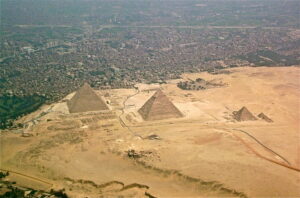
'Landscape' by Imhotep?
And/or: EIGHT. The Great Archangel, The Eight Archangels, The April Rainers, and Eight it is the Mornings’ break when all the world’s awake Oh. This last beautiful line of poetry gives us yet another surprising link out of apparent fancy which only makes sense within the cosmic interpretation of the song. The Eight Sphere, that of Glory, is linked to the Archangel Raphael. He is the Keeper of the Gates of Dawn, and his angels—the Bene Elohim—are the ‘inspirers’ who create new horizons within the intellect of mankind. It has been suggested that eight Archangels pose a problem, but there are no less than Ten Archangels upon the Tree of Life. As Raphael is an Archangel bearing a Sword, we may be reading the common confusion between Raphael/Michael/Saint George. In representations of these figures their attributes are often exchanged. The Great Archangel is usually Michael, but the Archangel of the Eighth Sphere is properly Raphael, although the two have been juxtaposed in some Qabalistic writings. Many carvings of Michael show him with a Sword, which is incorrect, as he is traditionally the Spear or Lance-bearer.
‘Eight it was a landscape’ is not open to mystical interpretation, but is good poetry within the song. {'Where is Saint George: Pagan Imagery in English Folksong / B. Stewart}.

The Venus of Hohle Fels (also known as the Venus of Schelklingen; in German variously Venus vom Hohlen Fels, vom Hohle Fels; Venus von Schelklingen) is an Upper Paleolithic Venus figurine made of mammoth ivory that was unearthed in 2008 in Hohle Fels, a cave near Schelklingen, Germany, part of the Caves and Ice Age Art in the Swabian Jura UNESCO World Heritage Site. It is dated to between 42,000 and 40,000 years ago,[1][2] belonging to the early Aurignacian, at the very beginning of the Upper Paleolithic, which is associated with the earliest presence of Cro-Magnons in Europe.
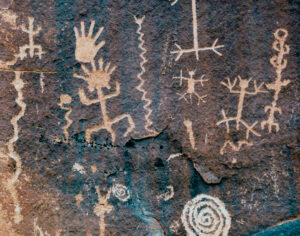
"The five pointed star, associated with the 'symbol at your door', is well known, though few people have bothered to explain its significance. It is the shape of a man standing upright with arms outstretched." {Page 84 'Where is Saint George: Pagan Imagery in English Folksong'}.
The Golden Legend (Latin: Legenda aurea or Legenda sanctorum) is a collection of 153 hagiographies by Jacobus de Voragine that was widely read in Europe during the Late Middle Ages. More than a thousand manuscripts of the text have survived.[1] It was probably compiled around 1259 to 1266, although the text was added to over the centuries.[2][3]
Initially entitled Legenda sanctorum (Readings of the Saints), it gained its popularity under the title by which it is best known. It overtook and eclipsed earlier compilations of abridged legendaria, the Abbreviatio in gestis et miraculis sanctorum attributed to the Dominican chronicler Jean de Mailly and the Epilogus in gestis sanctorum of the Dominican preacher Bartholomew of Trent. When printing was invented in the 1450s, editions appeared quickly, not only in Latin, but also in almost every major European language.[4] Among incunabula, printed before 1501, Legenda aurea was printed in more editions than the Bible[5] and was one of the most widely published books of the Middle Ages.[6] During the height of its popularity the book was so well known that the term "Golden Legend" was sometimes used generally to refer to any collection of stories about the saints.[7] It was one of the first books William Caxton printed in the English language; Caxton's version appeared in 1483 and his translation was reprinted, reaching a ninth edition in 1527.[8]

